class: right, middle, my-title, title-slide # Developing and using ecosystem <br />information in fishery management: ## Examples from the Northeast US<br /> 09 February 2021 ### Sarah Gaichas<br /> Northeast Fisheries Science Center<br /> Brandon Muffley<br /> Mid-Atlantic Fishery Management Council<br /> <br /> Many thanks to:<br /> Kimberly Bastille, Geret DePiper, Kimberly Hyde, Scott Large, Sean Lucey,<br /> and all SOE contributors --- class: top, left ## An integrated ecosystem assessment (IEA) success story (in progress) .pull-left-60[ - ICES WGNARS international science <a name=cite-depiper_operationalizing_2017></a>([DePiper, et al., 2017](https://academic.oup.com/icesjms/article/74/8/2076/3094701)) + Indicator development + Worked examples of IEA components - Ecosystem reporting linked to management objectives + Open science emphasis <a name=cite-bastille_improving_2020></a>([Bastille, et al., 2020](https://doi.org/10.1080/08920753.2021.1846155)) + Report evolving since 2016 + Fishery-relevant subset of full Ecosystem Status Reports - Used within Mid-Atlantic Fishery Management Council's Ecosystem Process <a name=cite-muffley_there_2020></a>([Muffley, et al., 2020](https://doi.org/10.1080/08920753.2021.1846156)) + Risk assessment <a name=cite-gaichas_implementing_2018></a>([Gaichas, et al., 2018](https://www.frontiersin.org/articles/10.3389/fmars.2018.00442/abstract)) + Conceptual modeling (DePiper et al., in review) + Management strategy evaluation (MSE) ] .pull-right-40[ *The IEA Loop<sup>1</sup>* 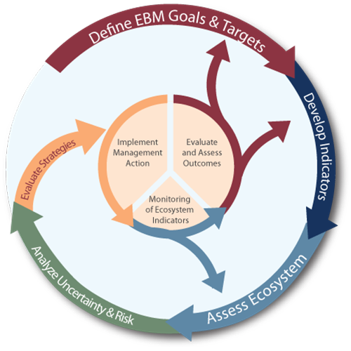 .footnote[ [1] https://www.integratedecosystemassessment.noaa.gov/national/IEA-approach ] ] ??? an iterative, collaborative process has evolved to formulate ecosystem advice and to apply it in decision making --- ## International scientific collaboration: [ICES WGNARS](https://www.ices.dk/community/groups/Pages/WGNARS.aspx) .pull-left[ .center[ 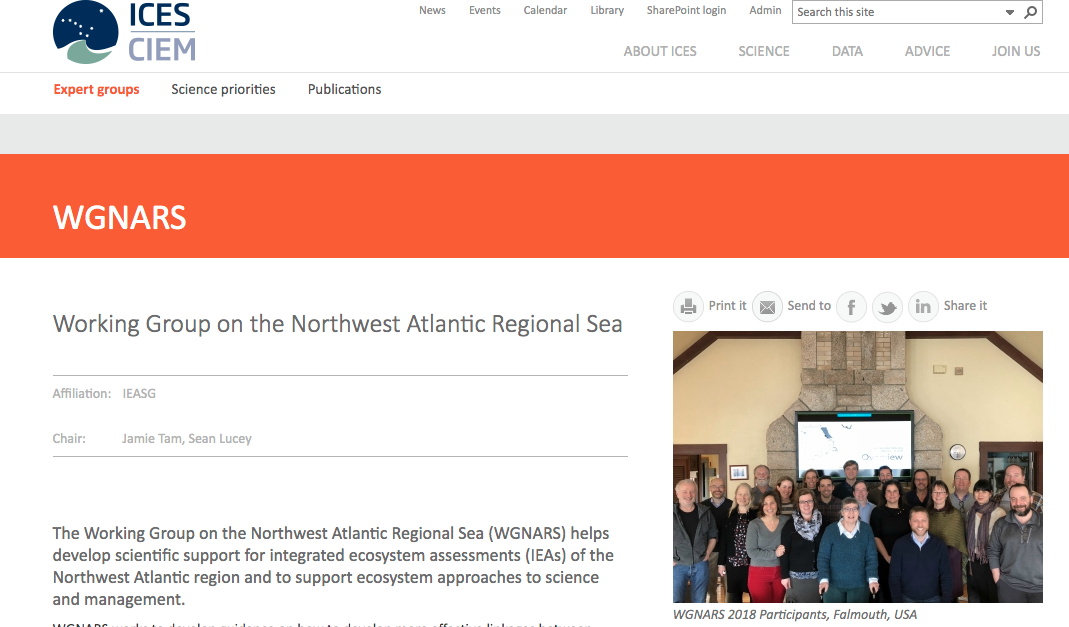 ] Deep dive into components of the IEA process from a scientific perspective * Outlining potential management objectives to start conversations with managers * Example ecosystem indicators, conceptual models, and risk assessments * Productive exchange between different national frameworks for EBFM/Ocean management and scientific databases ] .pull-right[ 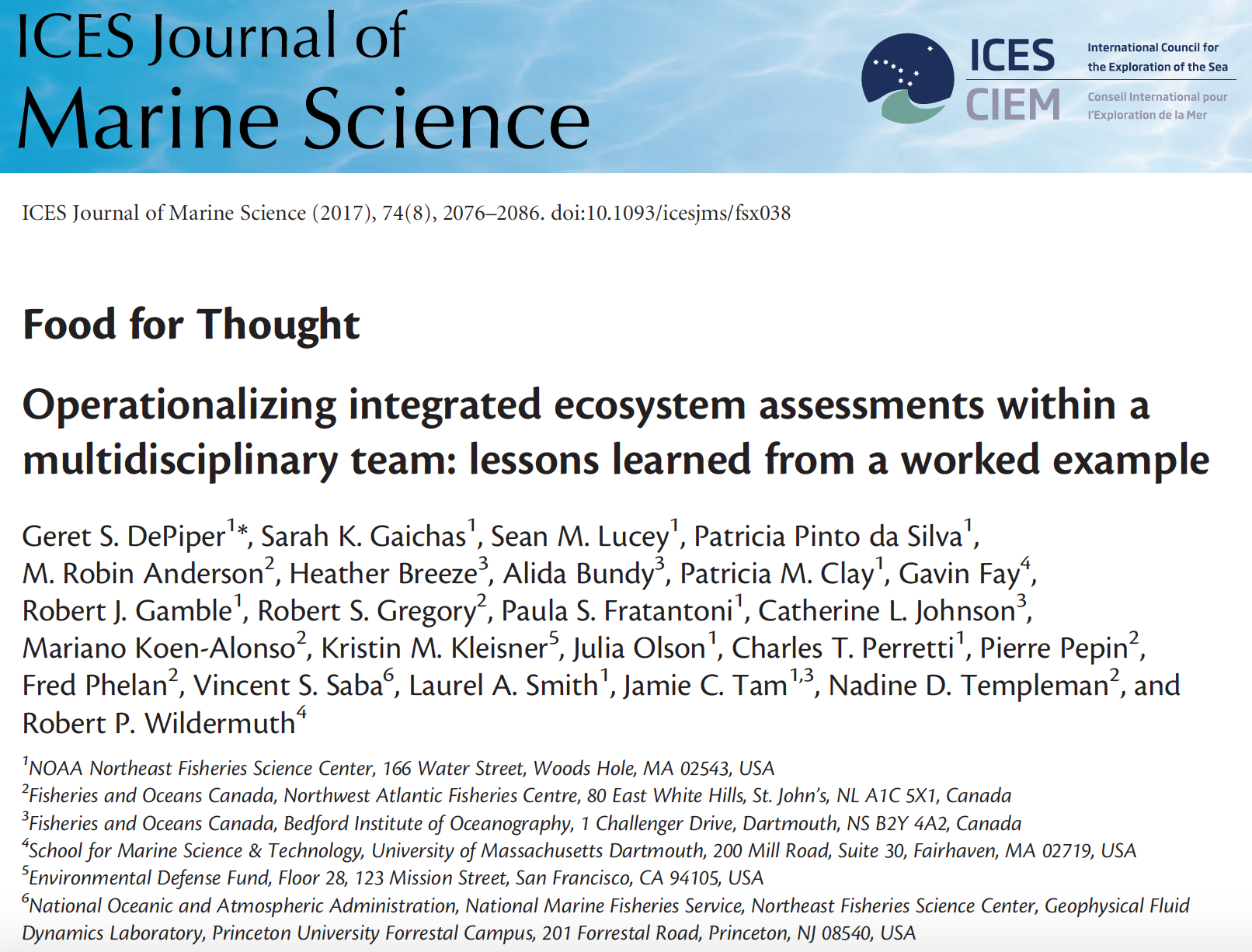 ] --- ## Collaborative process and worked examples ([DePiper, et al., 2017](https://academic.oup.com/icesjms/article/74/8/2076/3094701)) .pull-left[ 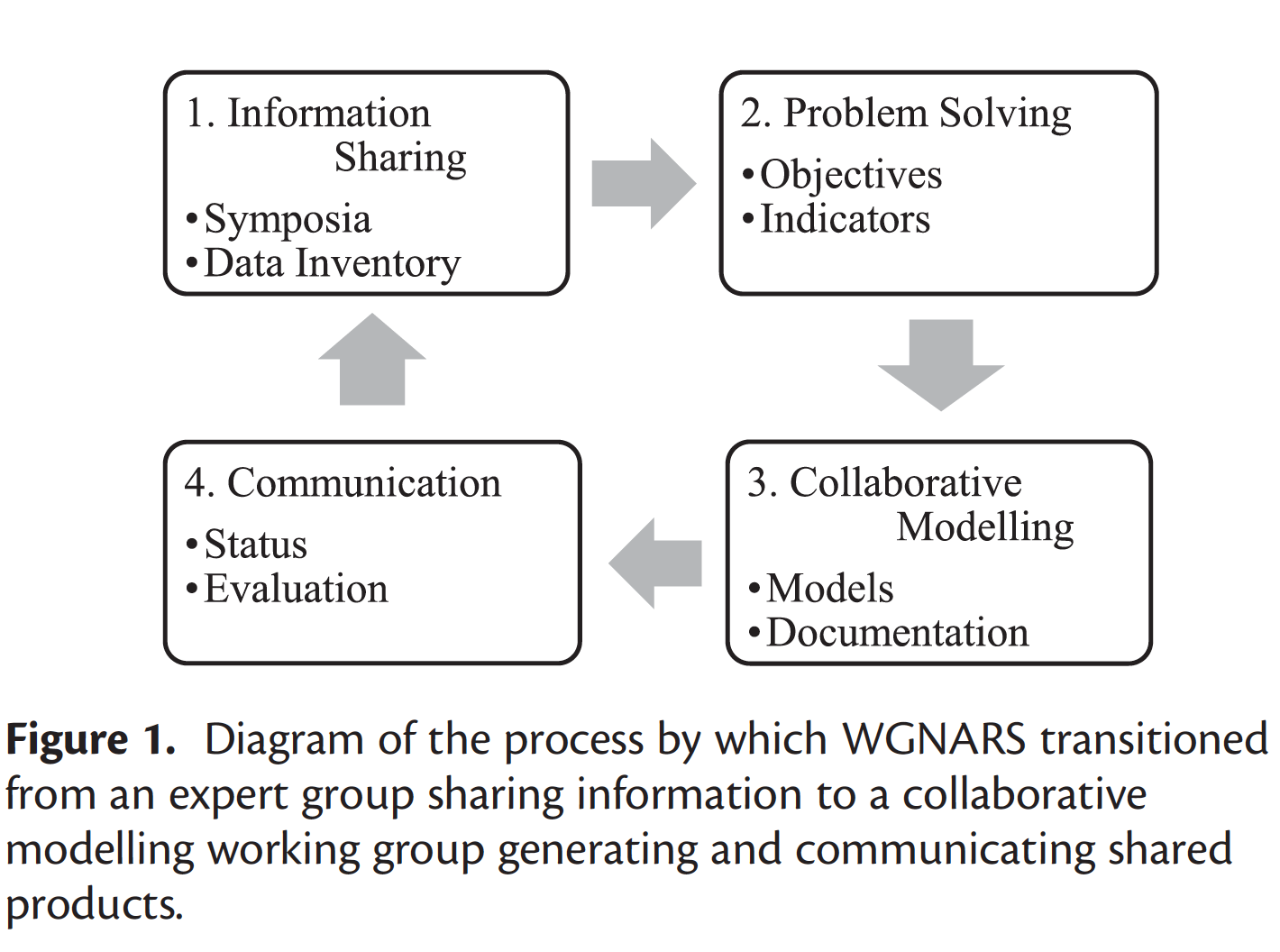 ] .pull-right[ 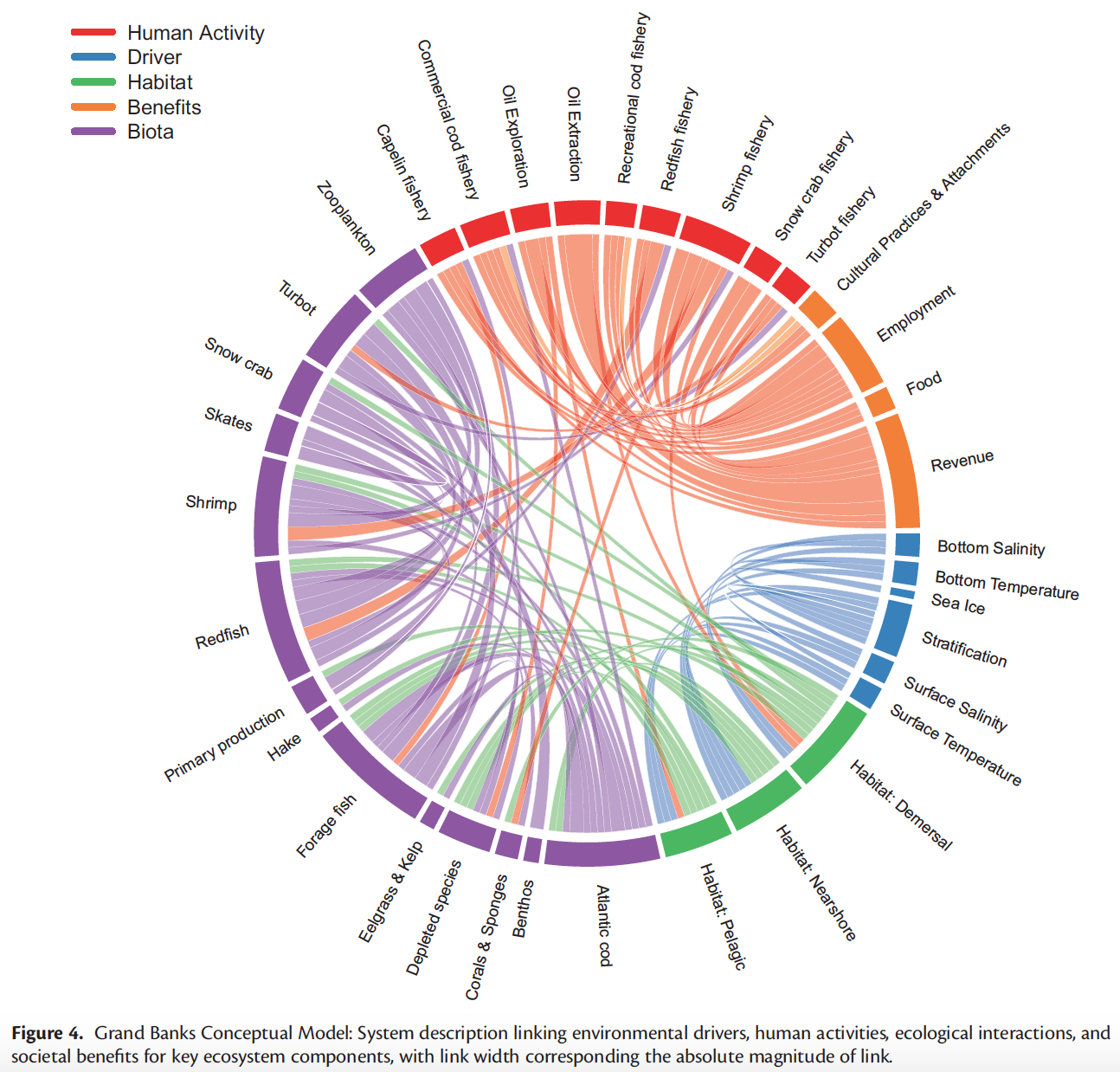 ] --- background-image: url("EDAB_images/nes-components-abstracted.png") background-size: 700px background-position: right bottom ## State of the Ecosystem (SOE) Reporting: Context for busy people *"So what?" --John Boreman, September 2016* 1. Clear linkage of ecosystem indicators with management objectives 1. Synthesis across indicators for big picture 1. Objectives related to human-well being placed first in report 1. Short (< 30 pages), non-technical (but rigorous) text 1. Emphasis on reproducibility ??? In 2016, we began taking steps to address these common critiques of the ESR model Many indicators presented at WGNARS, used in larger Ecosystem Status reports Shorter, fishery specific State of the Ecosystem (SOE) report with conceptual models prototyped based on California Current reporting Feedback from fishery managers redesigned reporting to align with objectives outlined by WGNARS --- ## State of the Ecosystem Report Structure .pull-left[ ## 2020 Report 1. Summary 2 pager 1. Human dimensions 1. Protected species 1. Fish and invertebrates (managed and otherwise) 1. Habitat quality and ecosystem productivity ## 2021 Report 1. Summary 2 pager + Page 1 summary table + Page 2 synthesis themes 1. Performance against management objectives 1. Risks ] .pull-right[ *Established ecosystem-scale objectives* <table class="table" style="font-size: 14px; margin-left: auto; margin-right: auto;"> <thead> <tr> <th style="text-align:left;font-weight: bold;"> Objective Categories </th> <th style="text-align:left;font-weight: bold;"> Indicators reported here </th> </tr> </thead> <tbody> <tr grouplength="4"><td colspan="2" style="border-bottom: 1px solid;"><strong>Provisioning/Cultural</strong></td></tr> <tr> <td style="text-align:left; padding-left: 2em;" indentlevel="1"> Seafood Production </td> <td style="text-align:left;"> Landings by feeding guild </td> </tr> <tr> <td style="text-align:left; padding-left: 2em;" indentlevel="1"> Profits </td> <td style="text-align:left;"> Revenue decomposed to price and volume </td> </tr> <tr> <td style="text-align:left; padding-left: 2em;" indentlevel="1"> Recreation </td> <td style="text-align:left;"> Days fished; recreational catch </td> </tr> <tr> <td style="text-align:left; padding-left: 2em;" indentlevel="1"> Social & Cultural </td> <td style="text-align:left;"> Commercial engagement trends </td> </tr> <tr grouplength="5"><td colspan="2" style="border-bottom: 1px solid;"><strong>Supporting/Regulating</strong></td></tr> <tr> <td style="text-align:left; padding-left: 2em;" indentlevel="1"> Stability </td> <td style="text-align:left;"> Diversity indices (fishery and species) </td> </tr> <tr> <td style="text-align:left; padding-left: 2em;" indentlevel="1"> Biomass </td> <td style="text-align:left;"> Biomass or abundance by feeding guild from surveys </td> </tr> <tr> <td style="text-align:left; padding-left: 2em;" indentlevel="1"> Productivity </td> <td style="text-align:left;"> Condition and recruitment of managed species, Primary productivity </td> </tr> <tr> <td style="text-align:left; padding-left: 2em;" indentlevel="1"> Trophic structure </td> <td style="text-align:left;"> Relative biomass of feeding guilds, Zooplankton </td> </tr> <tr> <td style="text-align:left; padding-left: 2em;" indentlevel="1"> Habitat </td> <td style="text-align:left;"> Estuarine and offshore habitat conditions </td> </tr> </tbody> </table> ] --- ## [2020 Report](https://doi.org/10.25923/1f8j-d564): Summary 2 pager with visualizations, 28 pages of narrative/plots, 1 page orientation .pull-left[ .center[ 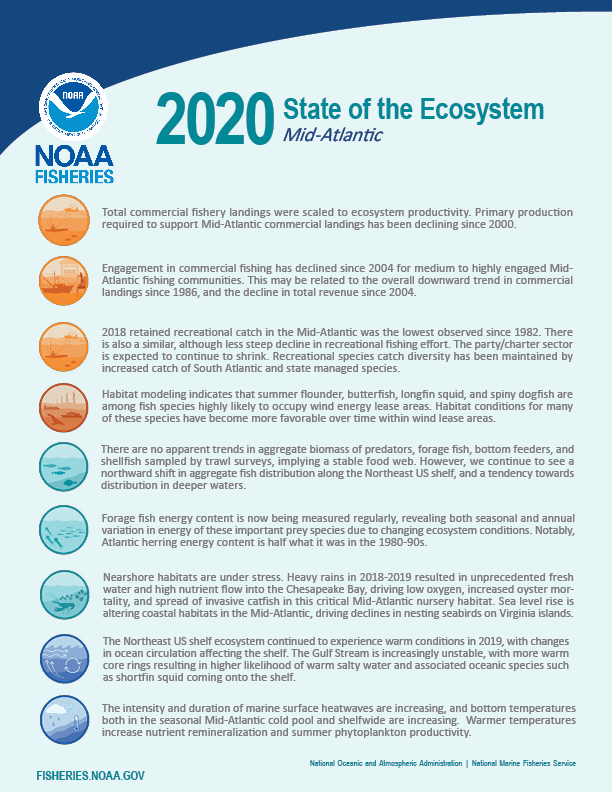 ] ] .pull-right[ .center[ 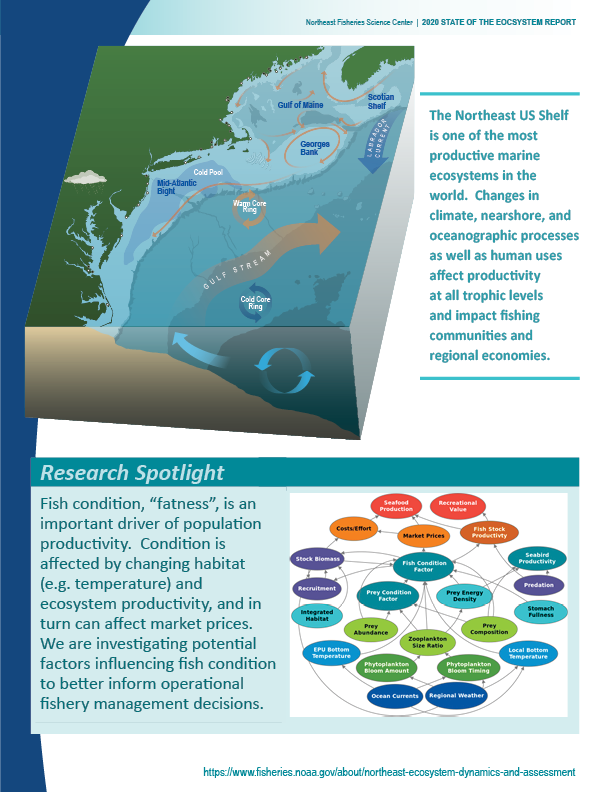 ] ] --- ## Ecosystem synthesis themes for 2021 Characterizing ecosystem change for fishery management: plain language summary for 2 pager * Multiple drivers of abundance, defined by the competing factors that influence the amount of fish in the ocean; * Regime shifts, or ecosystem change can happen rapidly as multiple drivers change; and, * Reorganization of the ecosystem, multiple factors that interact that change the structure and organization of the ecosystem, e.g. Tropicalization .pull-left[ 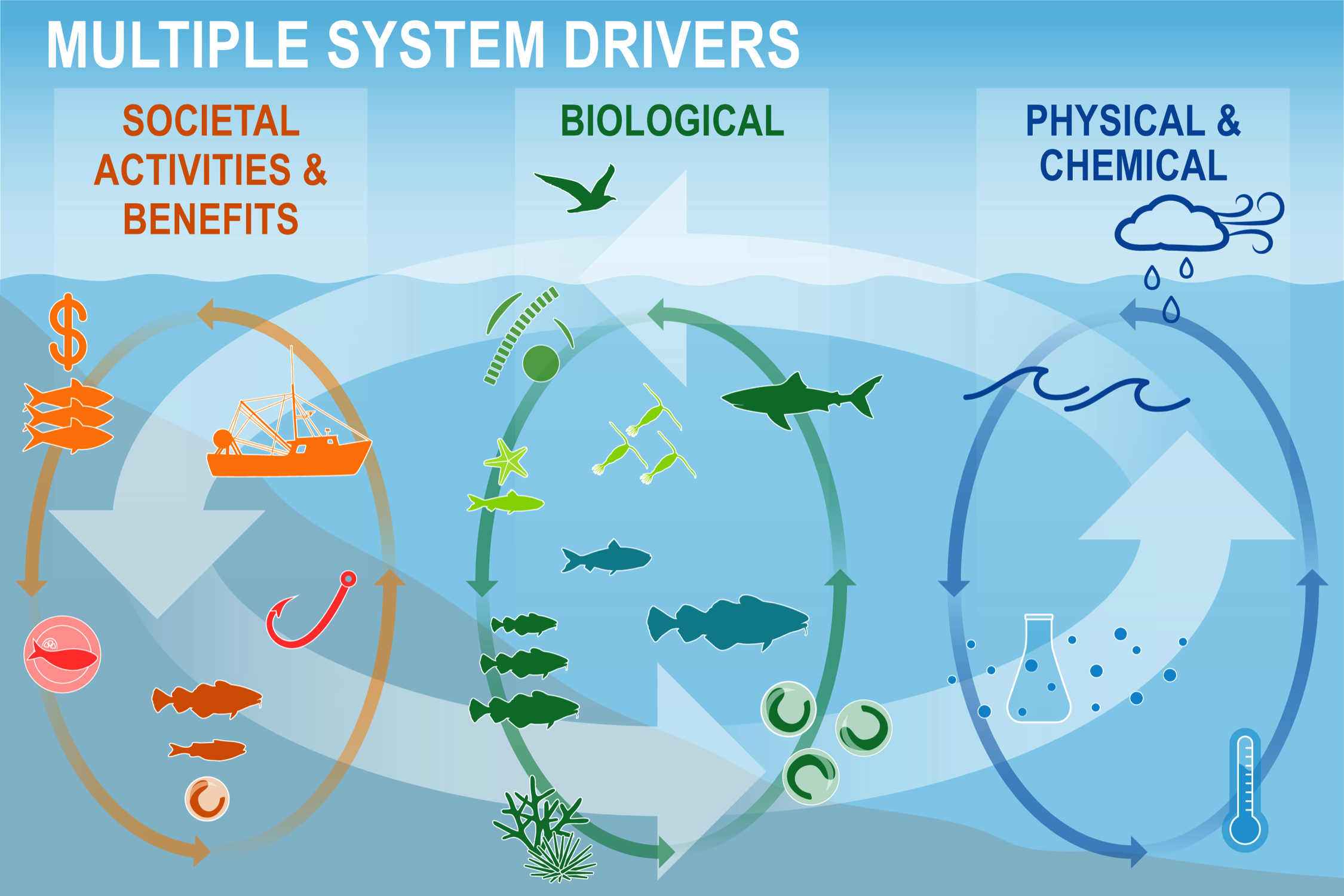 ] .pull-right[ 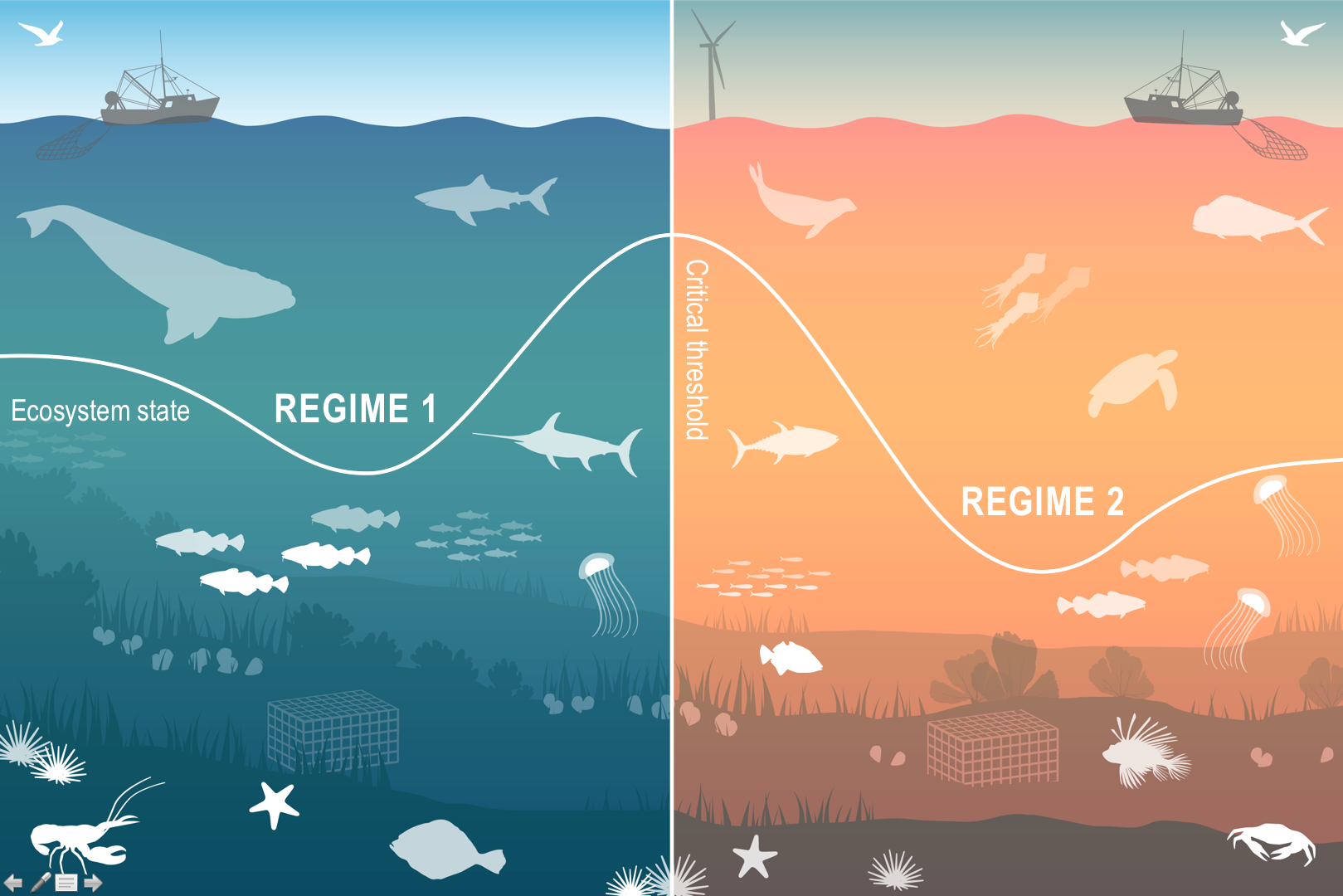 ] --- ## 2021 outline: two sections, each with "what" and "why" .pull-left[ * Performance against management objectives - *What* does the indicator say--up, down, stable? - *Why* do we think it is changing: integrates synthesis themes - Multiple drivers - Regime shifts - Ecosystem reorganization * Objectives - Seafood production - Profits - Recreational opportunities - Stability - Social and cultural - Protected species ] .pull-right[ * Risks - *What* does the indicator say--up, down, stable? - *Why* this is important to managers: integrates synthesis themes - Multiple drivers - Regime shifts - Ecosystem reorganization * Risk categories - Climate: warming, ocean currents, acidification - Habitat changes (incl. vulnerability analysis) - Productivity changes (system and fish) - Species interaction changes - Community structure changes - Other ocean uses - Wind ] --- ## Example: Seafood production objective .pull-left[ Indicator: Total landings Trend: Decreasing Mid-Atlantic <img src="20210209_DFO_EBFM_Gaichas_files/figure-html/unnamed-chunk-1-1.png" width="504" /> New England <img src="20210209_DFO_EBFM_Gaichas_files/figure-html/unnamed-chunk-3-1.png" width="504" style="display: block; margin: auto;" /> ] .pull-right[ Why: multiple drivers: stock status/management, engagement, markets, fish population drivers <img src="20210209_DFO_EBFM_Gaichas_files/figure-html/unnamed-chunk-5-1.png" width="504" style="display: block; margin: auto;" /> <img src="20210209_DFO_EBFM_Gaichas_files/figure-html/unnamed-chunk-6-1.png" width="504" style="display: block; margin: auto;" /> ] --- ## Multiple drivers of fish production analysis in progress: environment - fish condition - market price linkages 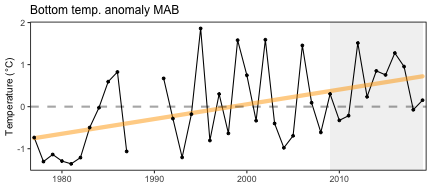 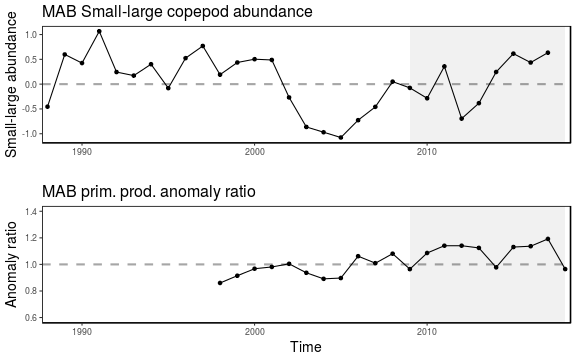 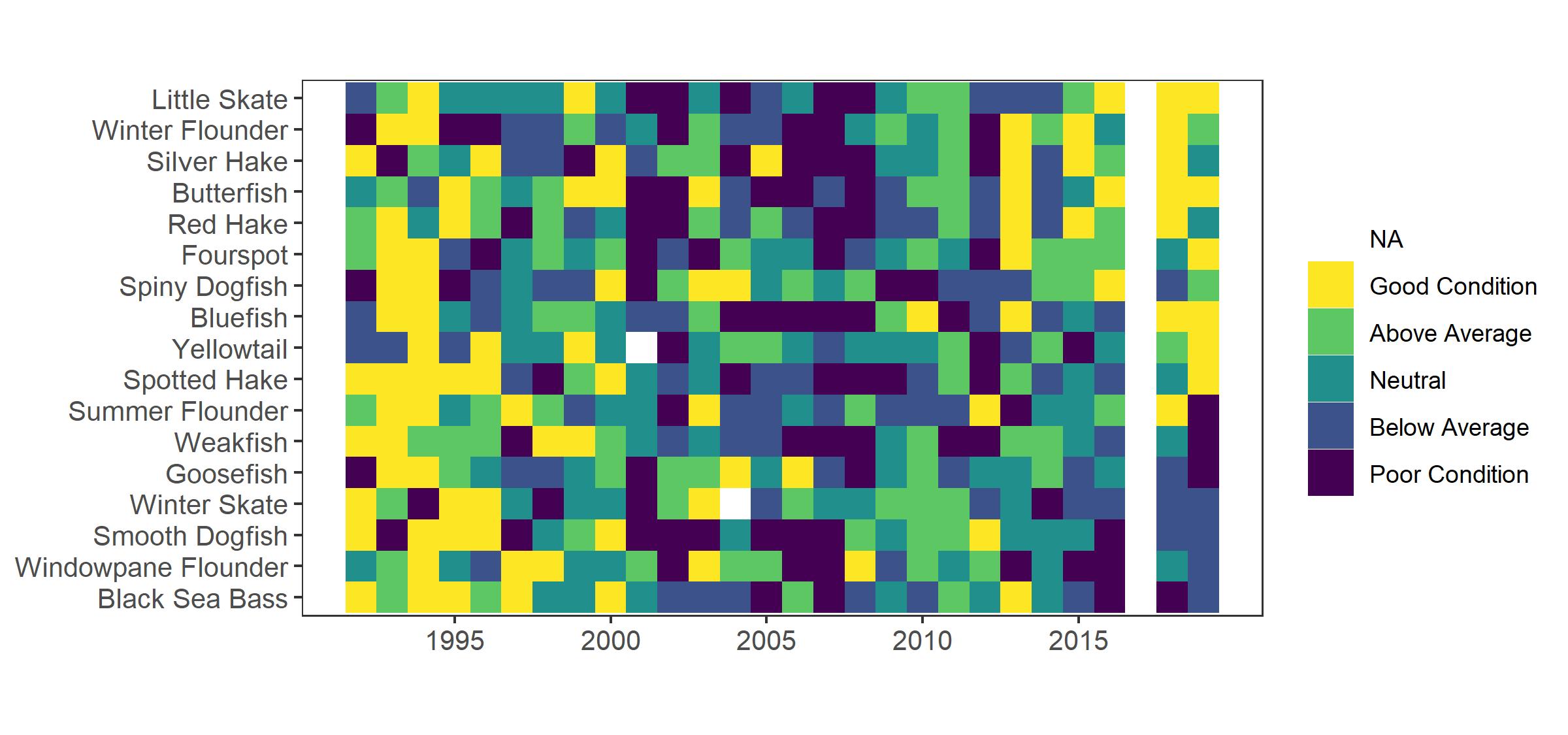 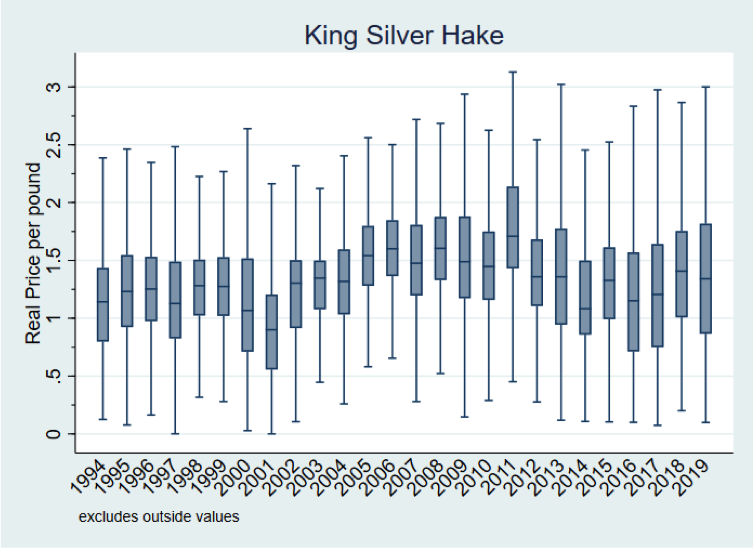 * Identify multiple and changing drivers of condition and market prices over time * Recognize regime shifts and potential system reorganization * Work in progress has identified the following potential drivers - *Temperature* - *Zooplankton* --- ## Example: Social and cultural objectives .pull-left[ Indicator: Recreational engagement, reliance, vulnerability <img src="20210209_DFO_EBFM_Gaichas_files/figure-html/unnamed-chunk-8-1.png" width="504" style="display: block; margin: auto;" /> Mid-Atlantic communities ] .pull-right[ Indicator: Commercial Vulnerability engagement, reliance, vulnerability <br /> <img src="20210209_DFO_EBFM_Gaichas_files/figure-html/unnamed-chunk-10-1.png" width="504" style="display: block; margin: auto;" /> ] --- ## Example: Protected species objectives .pull-left[ Indicators: Species By-catch <img src="20210209_DFO_EBFM_Gaichas_files/figure-html/unnamed-chunk-11-1.png" width="504" style="display: block; margin: auto;" /> <img src="20210209_DFO_EBFM_Gaichas_files/figure-html/unnamed-chunk-12-1.png" width="504" style="display: block; margin: auto;" /> ] .pull-right[ Indicators: Endangered Species Populations <img src="20210209_DFO_EBFM_Gaichas_files/figure-html/unnamed-chunk-13-1.png" width="504" style="display: block; margin: auto;" /> <img src="20210209_DFO_EBFM_Gaichas_files/figure-html/unnamed-chunk-14-1.png" width="504" style="display: block; margin: auto;" /> ] --- ## Example: Climate risks: multiple potential impacts on management .pull-left[ Indicators: Gulf Stream index, bottom and surface temperature, heat waves Trends: <img src="20210209_DFO_EBFM_Gaichas_files/figure-html/unnamed-chunk-16-1.png" width="60%" style="display: block; margin: auto;" /> <img src="20210209_DFO_EBFM_Gaichas_files/figure-html/unnamed-chunk-17-1.png" width="60%" style="display: block; margin: auto;" /> <img src="20210209_DFO_EBFM_Gaichas_files/figure-html/unnamed-chunk-18-1.png" width="70%" style="display: block; margin: auto;" /> ] .pull-right[ Why this matters: Habitat change from multiple drivers alters: - species distributions--allocation - system productivity--fishery resource productivity <img src="20210209_DFO_EBFM_Gaichas_files/figure-html/unnamed-chunk-19-1.png" width="504" style="display: block; margin: auto;" /> ] --- ## Example: Other ocean uses (Wind): area covered, fisheries impacted .pull-left[ 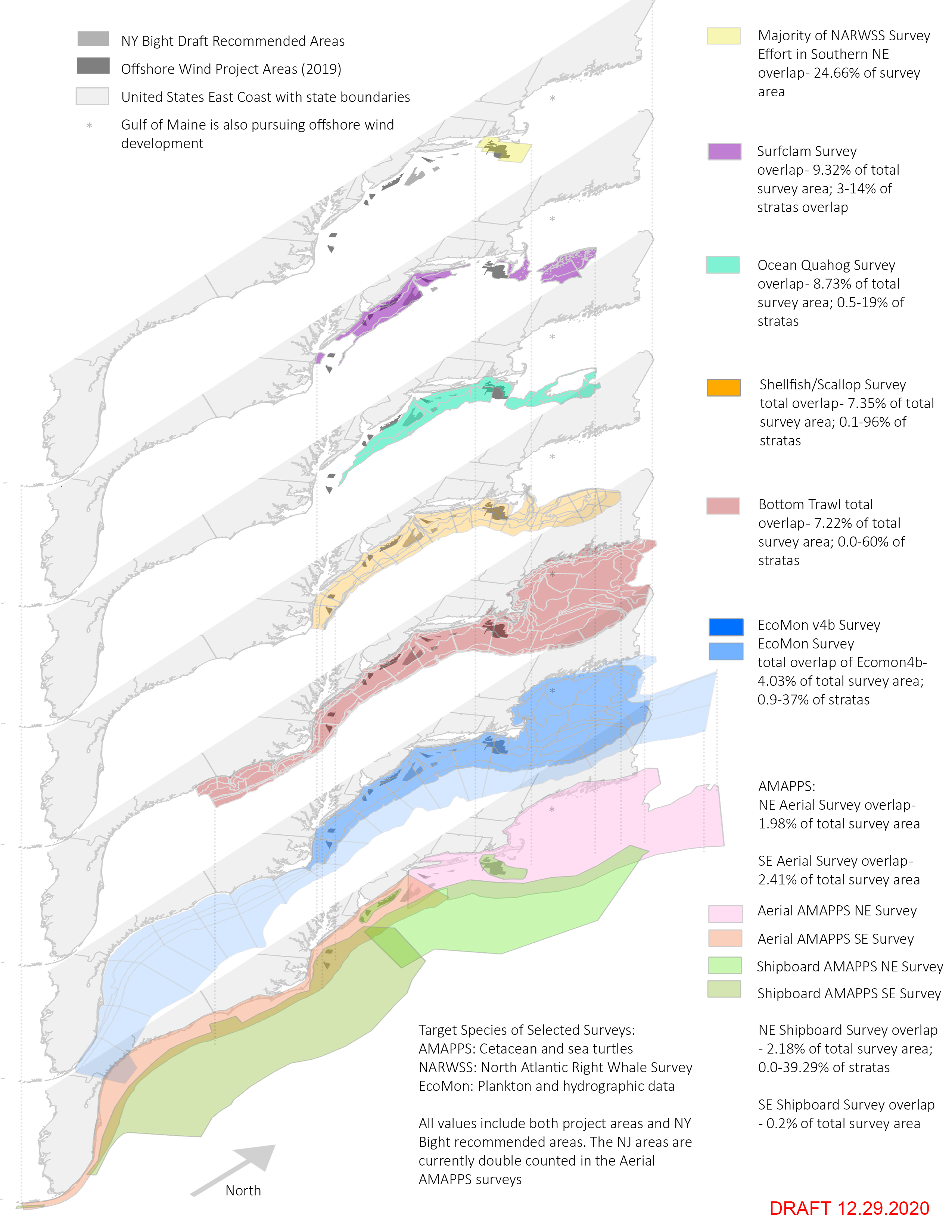 ] .pull-right[ <img src="20210209_DFO_EBFM_Gaichas_files/figure-html/unnamed-chunk-20-1.png" width="504" style="display: block; margin: auto;" /> <img src="20210209_DFO_EBFM_Gaichas_files/figure-html/unnamed-chunk-21-1.png" width="504" style="display: block; margin: auto;" /> ] --- ## Continuing dialogue with managers shapes report and indicators presented each year: 2021 Requests <table class="table" style="font-size: 9px; margin-left: auto; margin-right: auto;"> <thead> <tr> <th style="text-align:left;font-weight: bold;"> Request </th> <th style="text-align:right;font-weight: bold;"> Year </th> <th style="text-align:left;font-weight: bold;"> Source </th> <th style="text-align:left;font-weight: bold;"> Progress </th> <th style="text-align:left;font-weight: bold;"> Memo Section </th> </tr> </thead> <tbody> <tr> <td style="text-align:left;width: 8cm; "> Ecosystem Overfishing indicators (Link and Watson, 2019) </td> <td style="text-align:right;width: 1cm; "> 2020 </td> <td style="text-align:left;width: 2cm; "> Both Councils </td> <td style="text-align:left;width: 10cm; "> SOE total catch/area, total catch/PP, and total catch/Chl -- challenge is for total catch </td> <td style="text-align:left;width: 2cm; "> 1 </td> </tr> <tr> <td style="text-align:left;width: 8cm; "> Primary production required, interpretation of decline? </td> <td style="text-align:right;width: 1cm; "> 2020 </td> <td style="text-align:left;width: 2cm; "> Both Councils </td> <td style="text-align:left;width: 10cm; "> SOE indicator reworked to include some Link and Watson metrics </td> <td style="text-align:left;width: 2cm; "> 2 </td> </tr> <tr> <td style="text-align:left;width: 8cm; "> Climate Change context </td> <td style="text-align:right;width: 1cm; "> 2020 </td> <td style="text-align:left;width: 2cm; "> NEFMC </td> <td style="text-align:left;width: 10cm; "> SOE reorganized; Risks section added emphasizing climate change </td> <td style="text-align:left;width: 2cm; "> 3 </td> </tr> <tr> <td style="text-align:left;width: 8cm; "> Clarify language (e.g., primary production required) </td> <td style="text-align:right;width: 1cm; "> 2020 </td> <td style="text-align:left;width: 2cm; "> Both Councils </td> <td style="text-align:left;width: 10cm; "> RCB help requested </td> <td style="text-align:left;width: 2cm; "> 4 </td> </tr> <tr> <td style="text-align:left;width: 8cm; "> Copy Editing </td> <td style="text-align:right;width: 1cm; "> 2020 </td> <td style="text-align:left;width: 2cm; "> Both Councils </td> <td style="text-align:left;width: 10cm; "> RCB help requested </td> <td style="text-align:left;width: 2cm; "> 5 </td> </tr> <tr> <td style="text-align:left;width: 8cm; "> Ocean Acidification </td> <td style="text-align:right;width: 1cm; "> 2020 </td> <td style="text-align:left;width: 2cm; "> NEFMC </td> <td style="text-align:left;width: 10cm; "> SOE indicator added with in-situ data linked to preliminary lab work on thresholds </td> <td style="text-align:left;width: 2cm; "> 6 </td> </tr> <tr> <td style="text-align:left;width: 8cm; "> Include examples of High/Low engaged ports </td> <td style="text-align:right;width: 1cm; "> 2020 </td> <td style="text-align:left;width: 2cm; "> NEFMC </td> <td style="text-align:left;width: 10cm; "> SOE indicator reworked to show ports </td> <td style="text-align:left;width: 2cm; "> 7 </td> </tr> <tr> <td style="text-align:left;width: 8cm; "> Expand wind lease area and habitat overlap </td> <td style="text-align:right;width: 1cm; "> 2020 </td> <td style="text-align:left;width: 2cm; "> MAFMC </td> <td style="text-align:left;width: 10cm; "> SOE indicator expanded to rank species with habitat in wind lease areas by landings in wind lease areas </td> <td style="text-align:left;width: 2cm; "> 8 </td> </tr> <tr> <td style="text-align:left;width: 8cm; "> Expand cold pool index </td> <td style="text-align:right;width: 1cm; "> 2020 </td> <td style="text-align:left;width: 2cm; "> MAFMC </td> <td style="text-align:left;width: 10cm; "> SOE indicator expanded with modeled data to include area and other attributes </td> <td style="text-align:left;width: 2cm; "> 9 </td> </tr> <tr> <td style="text-align:left;width: 8cm; "> Shark diversity indicator </td> <td style="text-align:right;width: 1cm; "> 2020 </td> <td style="text-align:left;width: 2cm; "> MAFMC </td> <td style="text-align:left;width: 10cm; "> SOE multiple shark indicators added </td> <td style="text-align:left;width: 2cm; "> 10 </td> </tr> <tr> <td style="text-align:left;width: 8cm; "> Uncertainty estimates </td> <td style="text-align:right;width: 1cm; "> 2020 </td> <td style="text-align:left;width: 2cm; "> MAFMC </td> <td style="text-align:left;width: 10cm; "> SOE included for subset of indicators </td> <td style="text-align:left;width: 2cm; "> 11 </td> </tr> <tr> <td style="text-align:left;width: 8cm; "> Bycatch index </td> <td style="text-align:right;width: 1cm; "> 2020 </td> <td style="text-align:left;width: 2cm; "> NEFMC </td> <td style="text-align:left;width: 10cm; "> SOE added seal bycatch indicator, retained harbor porpoise indicator </td> <td style="text-align:left;width: 2cm; "> 12 </td> </tr> <tr> <td style="text-align:left;width: 8cm; "> Marine Mammal consumption </td> <td style="text-align:right;width: 1cm; "> 2019 </td> <td style="text-align:left;width: 2cm; "> MAFMC </td> <td style="text-align:left;width: 10cm; "> SOE added discussion of seal diets, memo no new consumption ests since Smith et al but could be in the future once work is complete </td> <td style="text-align:left;width: 2cm; "> 13 </td> </tr> <tr> <td style="text-align:left;width: 8cm; "> Estuarine Water Quality </td> <td style="text-align:right;width: 1cm; "> 2020 </td> <td style="text-align:left;width: 2cm; "> NEFMC </td> <td style="text-align:left;width: 10cm; "> SOE Chesapeake indicators updated and expanded </td> <td style="text-align:left;width: 2cm; "> 14 </td> </tr> <tr> <td style="text-align:left;width: 8cm; "> Linking Condition </td> <td style="text-align:right;width: 1cm; "> 2020 </td> <td style="text-align:left;width: 2cm; "> MAFMC </td> <td style="text-align:left;width: 10cm; "> in progress not ready for 2021 </td> <td style="text-align:left;width: 2cm; "> 15 </td> </tr> <tr> <td style="text-align:left;width: 8cm; "> Avg weight of diet components by feeding group </td> <td style="text-align:right;width: 1cm; "> 2019 </td> <td style="text-align:left;width: 2cm; "> Internal </td> <td style="text-align:left;width: 10cm; "> in progress part of fish condition ? stomach fullness analysis started--species level </td> <td style="text-align:left;width: 2cm; "> 16 </td> </tr> <tr> <td style="text-align:left;width: 8cm; "> Mean stomach weight across feeding guilds </td> <td style="text-align:right;width: 1cm; "> 2019 </td> <td style="text-align:left;width: 2cm; "> MAFMC </td> <td style="text-align:left;width: 10cm; "> in progress stomach fullness analysis started--species level </td> <td style="text-align:left;width: 2cm; "> 17 </td> </tr> <tr> <td style="text-align:left;width: 8cm; "> Shellfish growth/distribution linked to climate (system productivity) </td> <td style="text-align:right;width: 1cm; "> 2019 </td> <td style="text-align:left;width: 2cm; "> MAFMC </td> <td style="text-align:left;width: 10cm; "> in progress project with R Mann student to start 2021? </td> <td style="text-align:left;width: 2cm; "> 18 </td> </tr> <tr> <td style="text-align:left;width: 8cm; "> Cumulative weather index </td> <td style="text-align:right;width: 1cm; "> 2020 </td> <td style="text-align:left;width: 2cm; "> MAFMC </td> <td style="text-align:left;width: 10cm; "> in progress data gathered for prototype </td> <td style="text-align:left;width: 2cm; "> 19 </td> </tr> <tr> <td style="text-align:left;width: 8cm; "> Management complexity </td> <td style="text-align:right;width: 1cm; "> 2019 </td> <td style="text-align:left;width: 2cm; "> MAFMC </td> <td style="text-align:left;width: 10cm; "> in progress by summer student, needs further analysis, no further work in 2020 </td> <td style="text-align:left;width: 2cm; "> 20 </td> </tr> <tr> <td style="text-align:left;width: 8cm; "> VAST and uncertainty </td> <td style="text-align:right;width: 1cm; "> 2020 </td> <td style="text-align:left;width: 2cm; "> Both Councils </td> <td style="text-align:left;width: 10cm; "> ??? in progress not ready for 2021 </td> <td style="text-align:left;width: 2cm; "> 21 </td> </tr> <tr> <td style="text-align:left;width: 8cm; "> Seal index </td> <td style="text-align:right;width: 1cm; "> 2020 </td> <td style="text-align:left;width: 2cm; "> MAFMC </td> <td style="text-align:left;width: 10cm; "> ??? in progress not ready for 2021 </td> <td style="text-align:left;width: 2cm; "> 22 </td> </tr> <tr> <td style="text-align:left;width: 8cm; "> Seperate Bigelow/Albatross catch diversity metric </td> <td style="text-align:right;width: 1cm; "> 2020 </td> <td style="text-align:left;width: 2cm; "> MAFMC </td> <td style="text-align:left;width: 10cm; "> ??? not done </td> <td style="text-align:left;width: 2cm; "> 23 </td> </tr> <tr> <td style="text-align:left;width: 8cm; "> Incorporate social sciences survey from council </td> <td style="text-align:right;width: 1cm; "> 2020 </td> <td style="text-align:left;width: 2cm; "> NEFMC </td> <td style="text-align:left;width: 10cm; "> ??? check ??? not started </td> <td style="text-align:left;width: 2cm; "> 24 </td> </tr> <tr> <td style="text-align:left;width: 8cm; "> Young of Year index from multiple surveys </td> <td style="text-align:right;width: 1cm; "> 2019 </td> <td style="text-align:left;width: 2cm; "> MAFMC </td> <td style="text-align:left;width: 10cm; "> not started </td> <td style="text-align:left;width: 2cm; "> 25 </td> </tr> <tr> <td style="text-align:left;width: 8cm; "> Biomass of spp not included in BTS </td> <td style="text-align:right;width: 1cm; "> 2020 </td> <td style="text-align:left;width: 2cm; "> MAFMC </td> <td style="text-align:left;width: 10cm; "> not started </td> <td style="text-align:left;width: 2cm; "> 26 </td> </tr> <tr> <td style="text-align:left;width: 8cm; "> Estuarine condition relative to power plants and temp </td> <td style="text-align:right;width: 1cm; "> 2019 </td> <td style="text-align:left;width: 2cm; "> MAFMC </td> <td style="text-align:left;width: 10cm; "> not started </td> <td style="text-align:left;width: 2cm; "> 27 </td> </tr> <tr> <td style="text-align:left;width: 8cm; "> Inflection points for indicators </td> <td style="text-align:right;width: 1cm; "> 2019 </td> <td style="text-align:left;width: 2cm; "> Both Councils </td> <td style="text-align:left;width: 10cm; "> not started </td> <td style="text-align:left;width: 2cm; "> 28 </td> </tr> <tr> <td style="text-align:left;width: 8cm; "> Reduce indicator dimensionality with multivariate statistics </td> <td style="text-align:right;width: 1cm; "> 2020 </td> <td style="text-align:left;width: 2cm; "> NEFMC </td> <td style="text-align:left;width: 10cm; "> not started </td> <td style="text-align:left;width: 2cm; "> 29 </td> </tr> <tr> <td style="text-align:left;width: 8cm; "> Breakpoints </td> <td style="text-align:right;width: 1cm; "> 2020 </td> <td style="text-align:left;width: 2cm; "> NEFMC </td> <td style="text-align:left;width: 10cm; "> not started </td> <td style="text-align:left;width: 2cm; "> 30 </td> </tr> <tr> <td style="text-align:left;width: 8cm; "> Re-evaluate EPUs </td> <td style="text-align:right;width: 1cm; "> 2020 </td> <td style="text-align:left;width: 2cm; "> NEFMC </td> <td style="text-align:left;width: 10cm; "> not started </td> <td style="text-align:left;width: 2cm; "> 31 </td> </tr> </tbody> </table> --- ## Fishery management in the US Eight regional Fishery Management Councils establish plans for sustainable management of stocks within their jurisdictions. All are governed by the same law, but tailor management to their regional stakeholder needs. .center[ 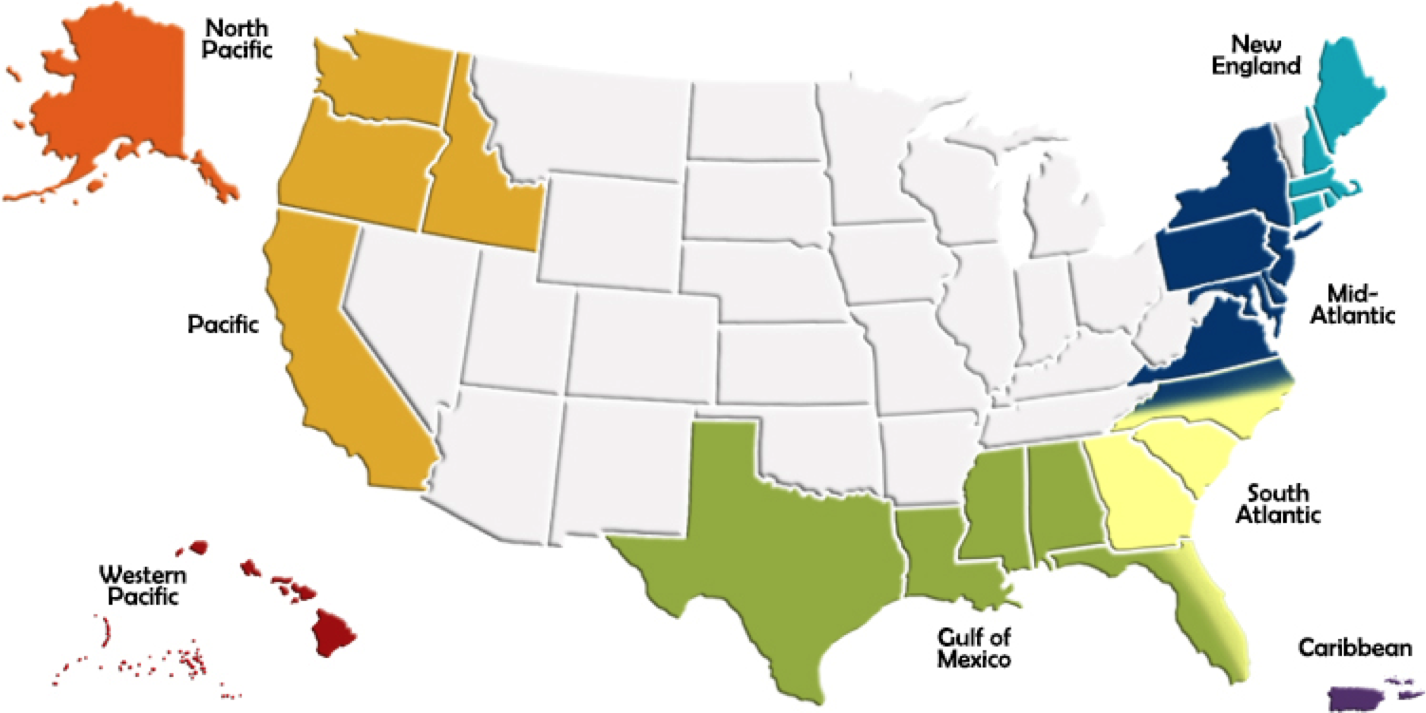 ] More information: http://www.fisherycouncils.org/ https://www.fisheries.noaa.gov/topic/laws-policies#magnuson-stevens-act --- ## The Mid-Atlantic Fishery Management Council (MAFMC) .pull-left-30[ 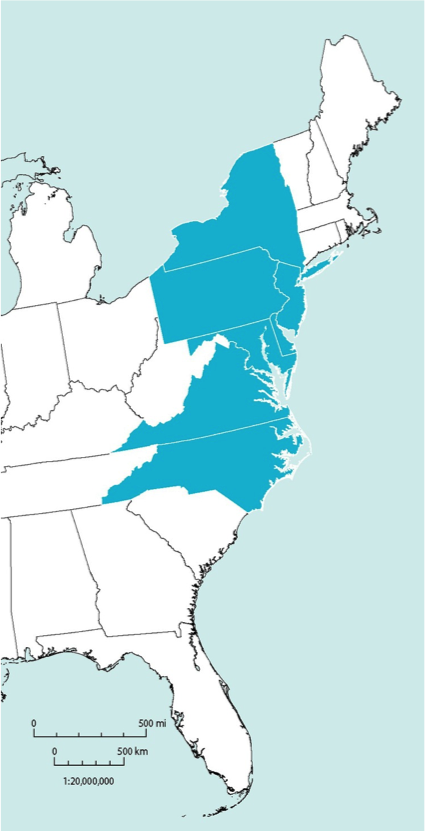 ] .pull-right-70[ 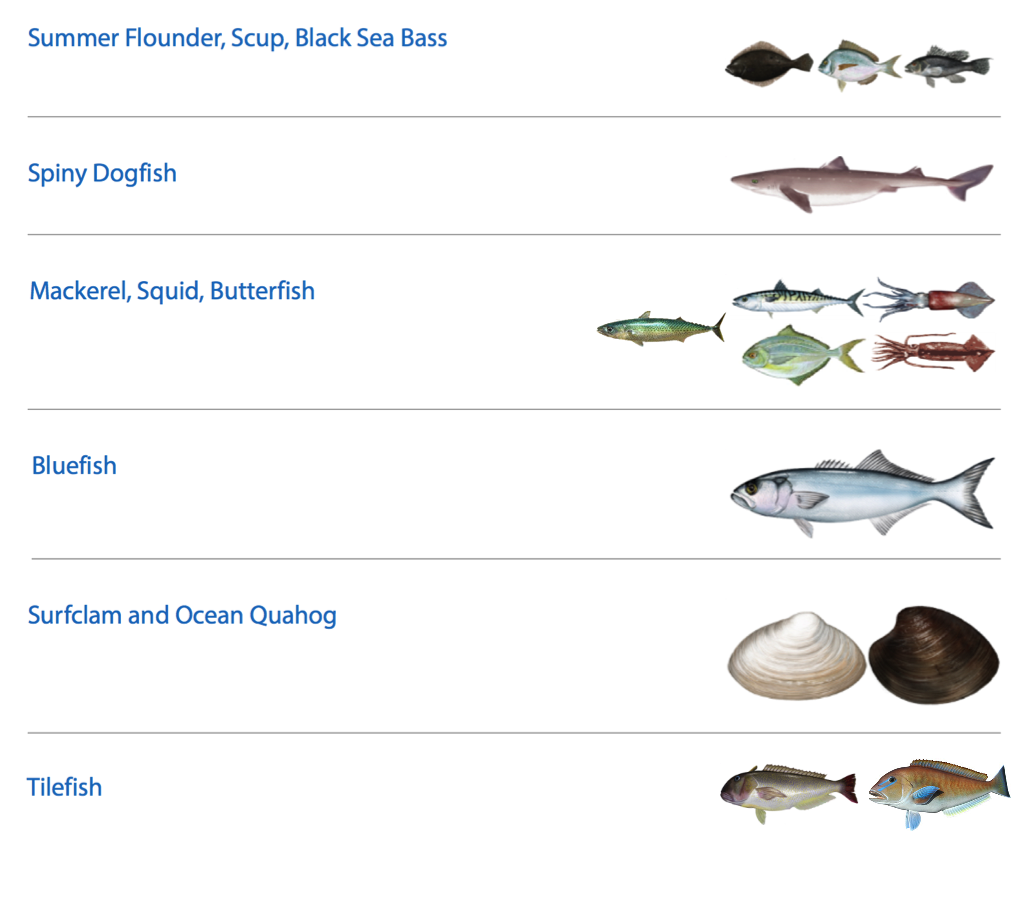 ] --- ## Why an ecosystem approach? *"We rebuilt all the stocks, so why is everyone still pissed off?" --Rich Seagraves* in 2011, the Council asked: .pull-left[ 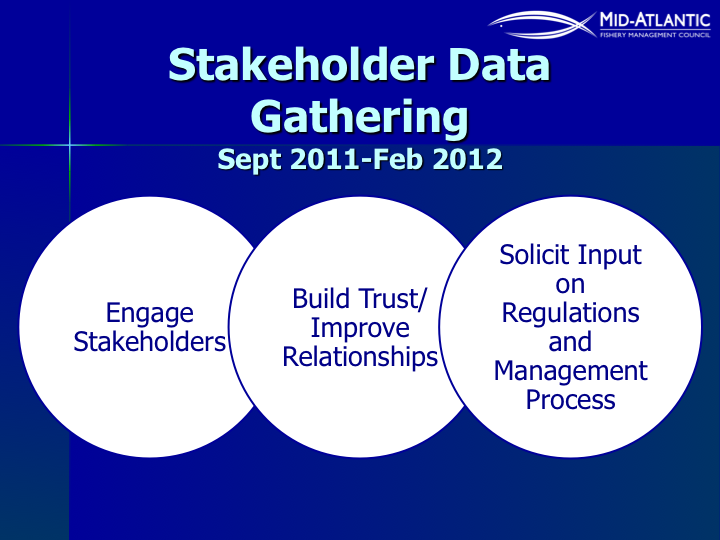 ] .pull-right[ 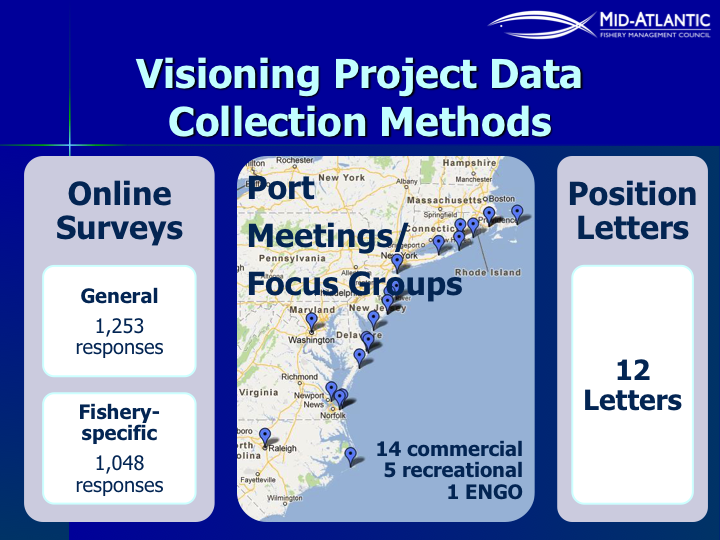 ] And many people answered, from commercial fishery, recreational fishery, environmental organization, and interested public perspectives. Visioning report: http://www.mafmc.org/s/MAFMC-stakeholder-input-report-p7b9.pdf --- ## Common themes among all stakeholder groups: >• There is a lack of confidence in the data that drive fishery management decisions. > >• Stakeholders are not as involved in the Council process as they can and should be. > >• Different jurisdictions and regulations among the many fishery management organizations result in complexity and inconsistency. > >• There is a need for increased transparency and communications in fisheries management. > >• The dynamics of the ecosystem and food web should be considered to a greater extent in fisheries management decisions. > >• Stakeholders are not adequately represented on the Council. > >• Pollution is negatively affecting the health of fish stocks. Visioning report, p. 3: http://www.mafmc.org/s/MAFMC-stakeholder-input-report-p7b9.pdf --- ## How did MAFMC develop their ecosystem approach? Visioning Project → Strategic Plan with one objective to develop >"A non-regulatory umbrella document intended to guide Council policy with respect to ecosystem considerations across existing Fishery Management Plans" .center[ 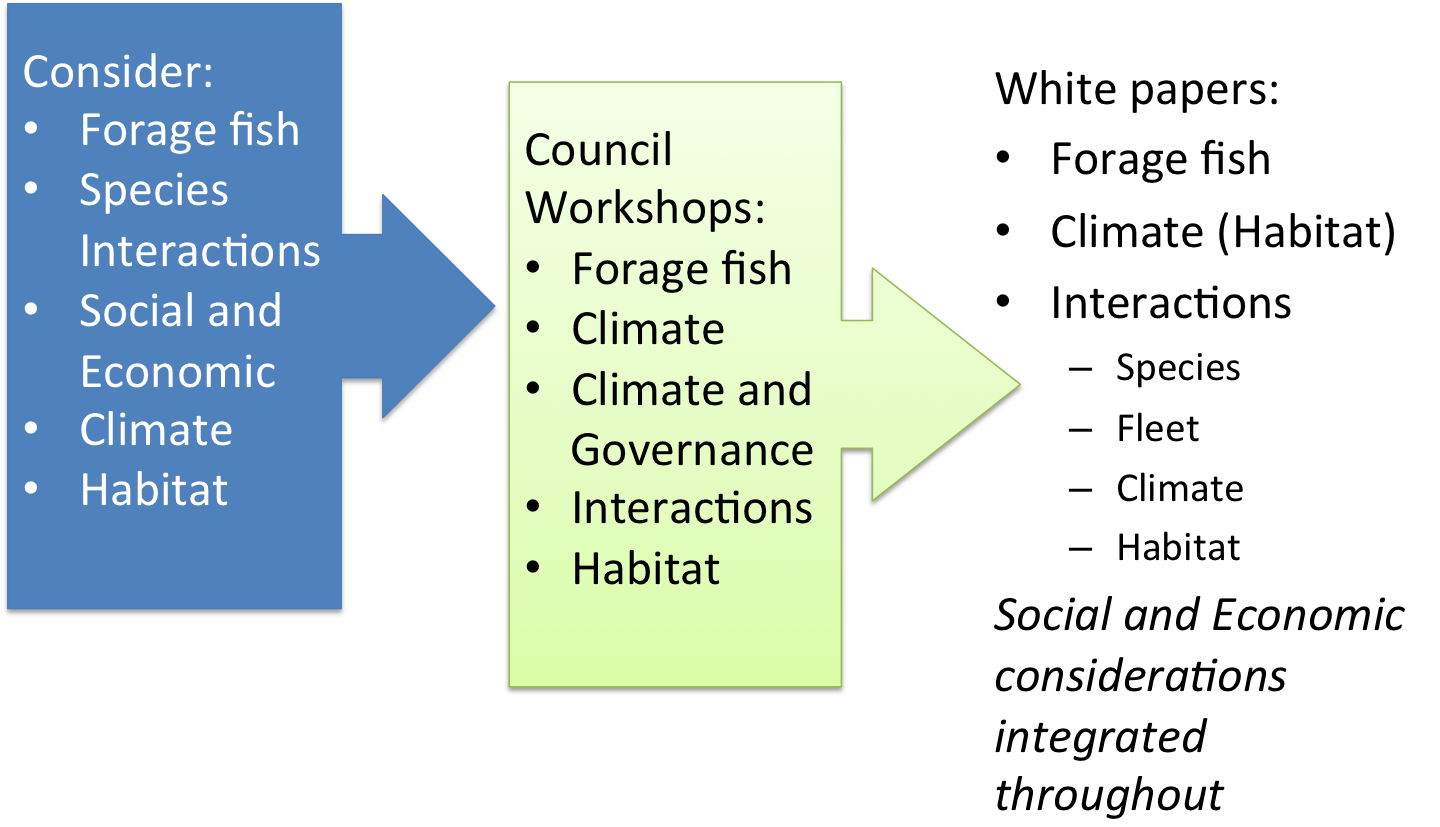 ] Details, including workshop presentations and white papers: http://www.mafmc.org/eafm ??? The Mid-Atlantic Council identified several theme areas from the visioning project as noted in the left panel of the workflow graphic: forage fish, species interactions, social and economic issues, climate and habitat. The Council held full day workshops during Council meetings where experts on the topics provided overviews and Council members asked questions and discussed the issues. Workships on Forage fish, Climate, Climate and Governance, Interactions (species and fleet), and Habitat were held between 2013 and 2015, resulting in white papers on Forage fish, Climate (and habitat), Interactions (species, fleet, climate, and habitat). Social and economic considerations were integrated in each workshop rather than looked at separately. --- ## Mid-Atlantic Council Ecosystem Approach * 2016 Ecosystem Approach to Fishery Management (EAFM) Policy Guidance document: http://www.mafmc.org/s/EAFM-Doc-Revised-2019-02-08.pdf * Mid-Atlantic EAFM framework <a name=cite-gaichas_framework_2016></a>([Gaichas, et al., 2016](https://www.frontiersin.org/articles/10.3389/fmars.2016.00105/full)): .center[ 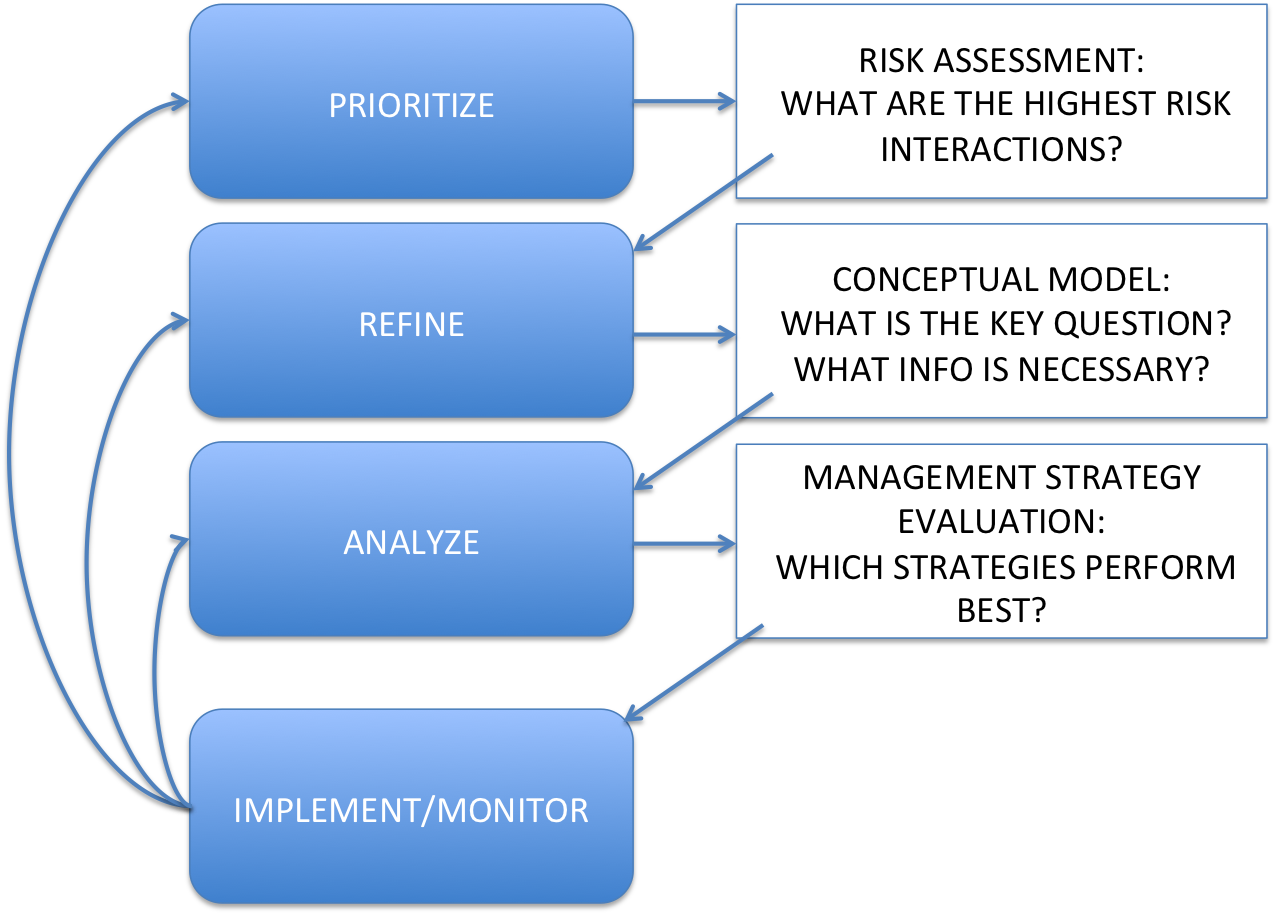 ] ??? The Council’s EAFM framework has similarities to the IEA loop on slide 2. It uses risk assessment as a first step to prioritize combinations of managed species, fleets, and ecosystem interactions for consideration. Second, a conceptual model is developed identifying key environmental, ecological, social, economic, and management linkages for a high-priority fishery. Third, quantitative modeling addressing Council-specified questions and based on interactions identified in the conceptual model is applied to evaluate alternative management strategies that best balance management objectives. As strategies are implemented, outcomes are monitored and the process is adjusted, and/or another priority identified in risk assessment can be addressed. --- background-image: url("EDAB_images/fmars-03-00105-g011.jpg") background-size: 700px background-position: right bottom ## Examples illustrating the use of the framework .pull-left-40[ 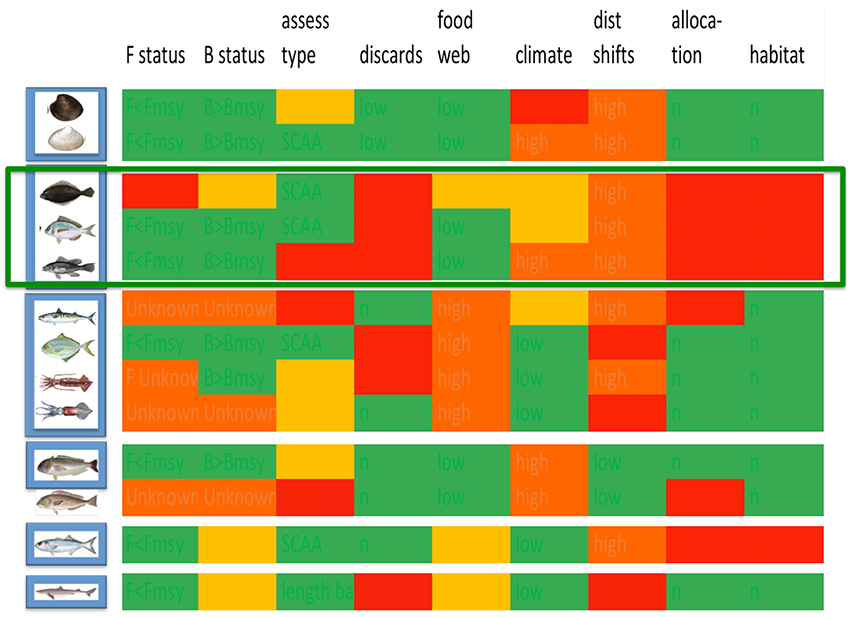 ] .pull-right-60[ Risk assessment highlights prority species/issues for more detailed evaluation A conceptual model maps out key interactions for high risk fisheries, specifies quantitative management strategy evaluation ] ??? Quoted from [Gaichas et al 2016](https://www.frontiersin.org/articles/10.3389/fmars.2016.00105/full) For this example, the [existing Mid Atlantic food web model](https://noaa-edab.github.io/tech-doc/conceptual-models.html) is used to define key species interactions for each managed species, habitat expertise is needed to link habitats to species, physical oceanographic and climate expertise is needed to link key climate drivers to habitats, and the expertise of fishermen, economists and other social scientists, and fishery managers is needed to link fish with fisheries and objectives for human well-being. The key link between fisheries and human well being objectives is identified as the system of regulatory allocations of total allowable catch between states along the Mid Atlantic coast. The interaction between this allocation system (based on historical catch) and climate-driven distribution shifts of the managed species has created considerable difficulty in this region. This conceptual model clearly connects climate considerations to management, as well as habitat considerations of concern to the Council but outside Council jurisdiction (water quality in coastal estuaries). --- ## Iterative development of the risk assessment .pull-left-40[  * Council staff and scientists create examples based on Council input ↑ ↓ ↑ ↓ ↑ ↓ ↑ ↓ ↑ ↓ ↑ ↓ ... * Council discusses, clarifies, revises with public input ] .pull-right-60[ <table class="table table-striped table-condensed" style="font-size: 11px; margin-left: auto; margin-right: auto;"> <thead> <tr> <th style="text-align:left;"> Element </th> <th style="text-align:left;"> Definition </th> <th style="text-align:left;"> Indicators </th> </tr> </thead> <tbody> <tr grouplength="4"><td colspan="3" style="border-bottom: 1px solid;"><strong>Economic</strong></td></tr> <tr> <td style="text-align:left; padding-left: 2em;" indentlevel="1"> Commercial Revenue </td> <td style="text-align:left;"> Risk of not maximizing fishery value </td> <td style="text-align:left;"> Revenue in aggregate </td> </tr> <tr> <td style="text-align:left; padding-left: 2em;" indentlevel="1"> Recreational Angler Days/Trips </td> <td style="text-align:left;"> Risk of not maximizing fishery value </td> <td style="text-align:left;"> Numbers of anglers and trips in aggregate </td> </tr> <tr> <td style="text-align:left; padding-left: 2em;" indentlevel="1"> Commercial Fishery Resilience (Revenue Diversity) </td> <td style="text-align:left;"> Risk of reduced fishery business resilience </td> <td style="text-align:left;"> Species diversity of revenue </td> </tr> <tr> <td style="text-align:left; padding-left: 2em;" indentlevel="1"> Commercial Fishery Resilience (Shoreside Support) </td> <td style="text-align:left;"> Risk of reduced fishery business resilience due to shoreside support infrastructure </td> <td style="text-align:left;"> Number of shoreside support businesses </td> </tr> <tr grouplength="2"><td colspan="3" style="border-bottom: 1px solid;"><strong>Social</strong></td></tr> <tr> <td style="text-align:left; padding-left: 2em;" indentlevel="1"> Fleet Resilience </td> <td style="text-align:left;"> Risk of reduced fishery resilience </td> <td style="text-align:left;"> Number of fleets, fleet diversity </td> </tr> <tr> <td style="text-align:left; padding-left: 2em;" indentlevel="1"> Social-Cultural </td> <td style="text-align:left;"> Risk of reduced community resilience </td> <td style="text-align:left;"> Community vulnerability, fishery engagement and reliance </td> </tr> <tr grouplength="2"><td colspan="3" style="border-bottom: 1px solid;"><strong>Food Production</strong></td></tr> <tr> <td style="text-align:left; padding-left: 2em;" indentlevel="1"> Commercial </td> <td style="text-align:left;"> Risk of not optimizing seafood production </td> <td style="text-align:left;"> Seafood landings in aggregate </td> </tr> <tr> <td style="text-align:left; padding-left: 2em;" indentlevel="1"> Recreational </td> <td style="text-align:left;"> Risk of not maintaining personal food production </td> <td style="text-align:left;"> Recreational landings in aggregate </td> </tr> </tbody> </table> ] --- ## Risk elements: Management <table class="table table-striped table-condensed" style="font-size: 14px; margin-left: auto; margin-right: auto;"> <thead> <tr> <th style="text-align:left;"> Element </th> <th style="text-align:left;"> Definition </th> <th style="text-align:left;"> Indicators </th> </tr> </thead> <tbody> <tr grouplength="6"><td colspan="3" style="border-bottom: 1px solid;"><strong>Management</strong></td></tr> <tr> <td style="text-align:left; padding-left: 2em;" indentlevel="1"> Control </td> <td style="text-align:left;"> Risk of not achieving OY due to inadequate control </td> <td style="text-align:left;"> Catch compared to allocation </td> </tr> <tr> <td style="text-align:left; padding-left: 2em;" indentlevel="1"> Interactions </td> <td style="text-align:left;"> Risk of not achieving OY due to interactions with species managed by other entities </td> <td style="text-align:left;"> Number and type of interactions with protected or non-MAFMC managed species, co-management </td> </tr> <tr> <td style="text-align:left; padding-left: 2em;" indentlevel="1"> Other ocean uses </td> <td style="text-align:left;"> Risk of not achieving OY due to other human uses </td> <td style="text-align:left;"> Fishery overlap with energy/mining areas </td> </tr> <tr> <td style="text-align:left; padding-left: 2em;" indentlevel="1"> Regulatory complexity </td> <td style="text-align:left;"> Risk of not achieving compliance due to complexity </td> <td style="text-align:left;"> Number of regulations by species </td> </tr> <tr> <td style="text-align:left; padding-left: 2em;" indentlevel="1"> Discards </td> <td style="text-align:left;"> Risk of not minimizing bycatch to extent practicable </td> <td style="text-align:left;"> Standardized Bycatch Reporting </td> </tr> <tr> <td style="text-align:left; padding-left: 2em;" indentlevel="1"> Allocation </td> <td style="text-align:left;"> Risk of not achieving OY due to spatial mismatch of stocks and management </td> <td style="text-align:left;"> Distribution shifts + number of interests </td> </tr> </tbody> </table> --- ## Risk assessent indicators and ranking criteria: Commercial revenue This element is applied at the ecosystem level. Revenue serves as a proxy for commercial profits. .table[ .pull-left[ <table> <thead> <tr> <th style="text-align:left;"> Risk Level </th> <th style="text-align:left;"> Definition </th> </tr> </thead> <tbody> <tr> <td style="text-align:left;width: 20em; "> Low </td> <td style="text-align:left;width: 20em; "> No trend and low variability in revenue </td> </tr> <tr> <td style="text-align:left;width: 20em; "> Low-Moderate </td> <td style="text-align:left;width: 20em; "> Increasing or high variability in revenue </td> </tr> <tr> <td style="text-align:left;width: 20em; font-weight: bold;background-color: orange !important;"> Moderate-High </td> <td style="text-align:left;width: 20em; font-weight: bold;background-color: orange !important;"> Significant long term revenue decrease </td> </tr> <tr> <td style="text-align:left;width: 20em; "> High </td> <td style="text-align:left;width: 20em; "> Significant recent decrease in revenue </td> </tr> </tbody> </table> Ranked moderate-high risk due to the significant long term revenue decrease for Mid-Atlantic managed species (red points in top plot) ] ] .pull-right[ <div class="figure" style="text-align: center"> <img src="20210209_DFO_EBFM_Gaichas_files/figure-html/total-rev-1.png" alt="Total revenue for the region (black) and revenue from MAFMC managed species (red)." width="432" /> <p class="caption">Total revenue for the region (black) and revenue from MAFMC managed species (red).</p> </div> ] --- ## EAFM Risk Assessment: 2020 update Management elements updated from original 2017 risk assessment; added risk rankings for chub mackerel and unmanaged forage fish. ### Decreased Risk (5) * Regulatory complexity risk for summer flounder decreased from high to med-high due to increased consistency in recent years * Technical interaction risk for commercial scup decreased from med-high to low-med because no accountability measures have been triggered * Allocation risks for recreational Atlantic mackerel, commercial longfin squid, and commercial spiny dogfish dropped from high to low due to changes in management approaches ### Increased Risk (15) * Bluefish status went from not overfished to overfished * Increased discards (5), reduced management control (4), allocation (3), other ocean uses (1), regulatory complexity (1) --- ## EAFM Risk Assessment: 2020 .pull-left[ *Species level risk elements* <table class="risktable table" style="font-size: 9px; margin-left: auto; margin-right: auto;"> <thead> <tr> <th style="text-align:left;"> Species </th> <th style="text-align:left;"> Assess </th> <th style="text-align:left;"> Fstatus </th> <th style="text-align:left;"> Bstatus </th> <th style="text-align:left;"> FW1Pred </th> <th style="text-align:left;"> FW1Prey </th> <th style="text-align:left;"> FW2Prey </th> <th style="text-align:left;"> Climate </th> <th style="text-align:left;"> DistShift </th> <th style="text-align:left;"> EstHabitat </th> </tr> </thead> <tbody> <tr> <td style="text-align:left;"> Ocean Quahog </td> <td style="text-align:left;"> <span style=" color: black !important;padding-right: 4px; padding-left: 4px; background-color: lightgreen !important;text-align: c;">lowest</span> </td> <td style="text-align:left;"> <span style=" color: black !important;padding-right: 4px; padding-left: 4px; background-color: lightgreen !important;text-align: c;">lowest</span> </td> <td style="text-align:left;"> <span style=" color: black !important;padding-right: 4px; padding-left: 4px; background-color: lightgreen !important;text-align: c;">lowest</span> </td> <td style="text-align:left;"> <span style=" color: black !important;padding-right: 4px; padding-left: 4px; background-color: lightgreen !important;text-align: c;">lowest</span> </td> <td style="text-align:left;"> <span style=" color: black !important;padding-right: 4px; padding-left: 4px; background-color: lightgreen !important;text-align: c;">lowest</span> </td> <td style="text-align:left;"> <span style=" color: black !important;padding-right: 4px; padding-left: 4px; background-color: lightgreen !important;text-align: c;">lowest</span> </td> <td style="text-align:left;"> <span style=" color: white !important;padding-right: 4px; padding-left: 4px; background-color: red !important;text-align: c;">highest</span> </td> <td style="text-align:left;"> <span style=" color: black !important;padding-right: 4px; padding-left: 4px; background-color: orange !important;text-align: c;">modhigh</span> </td> <td style="text-align:left;"> <span style=" color: black !important;padding-right: 4px; padding-left: 4px; background-color: lightgreen !important;text-align: c;">lowest</span> </td> </tr> <tr> <td style="text-align:left;"> Surfclam </td> <td style="text-align:left;"> <span style=" color: black !important;padding-right: 4px; padding-left: 4px; background-color: lightgreen !important;text-align: c;">lowest</span> </td> <td style="text-align:left;"> <span style=" color: black !important;padding-right: 4px; padding-left: 4px; background-color: lightgreen !important;text-align: c;">lowest</span> </td> <td style="text-align:left;"> <span style=" color: black !important;padding-right: 4px; padding-left: 4px; background-color: lightgreen !important;text-align: c;">lowest</span> </td> <td style="text-align:left;"> <span style=" color: black !important;padding-right: 4px; padding-left: 4px; background-color: lightgreen !important;text-align: c;">lowest</span> </td> <td style="text-align:left;"> <span style=" color: black !important;padding-right: 4px; padding-left: 4px; background-color: lightgreen !important;text-align: c;">lowest</span> </td> <td style="text-align:left;"> <span style=" color: black !important;padding-right: 4px; padding-left: 4px; background-color: lightgreen !important;text-align: c;">lowest</span> </td> <td style="text-align:left;"> <span style=" color: black !important;padding-right: 4px; padding-left: 4px; background-color: orange !important;text-align: c;">modhigh</span> </td> <td style="text-align:left;"> <span style=" color: black !important;padding-right: 4px; padding-left: 4px; background-color: orange !important;text-align: c;">modhigh</span> </td> <td style="text-align:left;"> <span style=" color: black !important;padding-right: 4px; padding-left: 4px; background-color: lightgreen !important;text-align: c;">lowest</span> </td> </tr> <tr> <td style="text-align:left;"> Summer flounder </td> <td style="text-align:left;"> <span style=" color: black !important;padding-right: 4px; padding-left: 4px; background-color: lightgreen !important;text-align: c;">lowest</span> </td> <td style="text-align:left;"> <span style=" color: black !important;padding-right: 4px; padding-left: 4px; background-color: lightgreen !important;text-align: c;">lowest</span> </td> <td style="text-align:left;"> <span style=" color: black !important;padding-right: 4px; padding-left: 4px; background-color: yellow !important;text-align: c;">lowmod</span> </td> <td style="text-align:left;"> <span style=" color: black !important;padding-right: 4px; padding-left: 4px; background-color: lightgreen !important;text-align: c;">lowest</span> </td> <td style="text-align:left;"> <span style=" color: black !important;padding-right: 4px; padding-left: 4px; background-color: lightgreen !important;text-align: c;">lowest</span> </td> <td style="text-align:left;"> <span style=" color: black !important;padding-right: 4px; padding-left: 4px; background-color: lightgreen !important;text-align: c;">lowest</span> </td> <td style="text-align:left;"> <span style=" color: black !important;padding-right: 4px; padding-left: 4px; background-color: yellow !important;text-align: c;">lowmod</span> </td> <td style="text-align:left;"> <span style=" color: black !important;padding-right: 4px; padding-left: 4px; background-color: orange !important;text-align: c;">modhigh</span> </td> <td style="text-align:left;"> <span style=" color: white !important;padding-right: 4px; padding-left: 4px; background-color: red !important;text-align: c;">highest</span> </td> </tr> <tr> <td style="text-align:left;"> Scup </td> <td style="text-align:left;"> <span style=" color: black !important;padding-right: 4px; padding-left: 4px; background-color: lightgreen !important;text-align: c;">lowest</span> </td> <td style="text-align:left;"> <span style=" color: black !important;padding-right: 4px; padding-left: 4px; background-color: lightgreen !important;text-align: c;">lowest</span> </td> <td style="text-align:left;"> <span style=" color: black !important;padding-right: 4px; padding-left: 4px; background-color: lightgreen !important;text-align: c;">lowest</span> </td> <td style="text-align:left;"> <span style=" color: black !important;padding-right: 4px; padding-left: 4px; background-color: lightgreen !important;text-align: c;">lowest</span> </td> <td style="text-align:left;"> <span style=" color: black !important;padding-right: 4px; padding-left: 4px; background-color: lightgreen !important;text-align: c;">lowest</span> </td> <td style="text-align:left;"> <span style=" color: black !important;padding-right: 4px; padding-left: 4px; background-color: lightgreen !important;text-align: c;">lowest</span> </td> <td style="text-align:left;"> <span style=" color: black !important;padding-right: 4px; padding-left: 4px; background-color: yellow !important;text-align: c;">lowmod</span> </td> <td style="text-align:left;"> <span style=" color: black !important;padding-right: 4px; padding-left: 4px; background-color: orange !important;text-align: c;">modhigh</span> </td> <td style="text-align:left;"> <span style=" color: white !important;padding-right: 4px; padding-left: 4px; background-color: red !important;text-align: c;">highest</span> </td> </tr> <tr> <td style="text-align:left;"> Black sea bass </td> <td style="text-align:left;"> <span style=" color: black !important;padding-right: 4px; padding-left: 4px; background-color: lightgreen !important;text-align: c;">lowest</span> </td> <td style="text-align:left;"> <span style=" color: black !important;padding-right: 4px; padding-left: 4px; background-color: lightgreen !important;text-align: c;">lowest</span> </td> <td style="text-align:left;"> <span style=" color: black !important;padding-right: 4px; padding-left: 4px; background-color: lightgreen !important;text-align: c;">lowest</span> </td> <td style="text-align:left;"> <span style=" color: black !important;padding-right: 4px; padding-left: 4px; background-color: lightgreen !important;text-align: c;">lowest</span> </td> <td style="text-align:left;"> <span style=" color: black !important;padding-right: 4px; padding-left: 4px; background-color: lightgreen !important;text-align: c;">lowest</span> </td> <td style="text-align:left;"> <span style=" color: black !important;padding-right: 4px; padding-left: 4px; background-color: lightgreen !important;text-align: c;">lowest</span> </td> <td style="text-align:left;"> <span style=" color: black !important;padding-right: 4px; padding-left: 4px; background-color: orange !important;text-align: c;">modhigh</span> </td> <td style="text-align:left;"> <span style=" color: black !important;padding-right: 4px; padding-left: 4px; background-color: orange !important;text-align: c;">modhigh</span> </td> <td style="text-align:left;"> <span style=" color: white !important;padding-right: 4px; padding-left: 4px; background-color: red !important;text-align: c;">highest</span> </td> </tr> <tr> <td style="text-align:left;"> Atl. mackerel </td> <td style="text-align:left;"> <span style=" color: black !important;padding-right: 4px; padding-left: 4px; background-color: lightgreen !important;text-align: c;">lowest</span> </td> <td style="text-align:left;"> <span style=" color: white !important;padding-right: 4px; padding-left: 4px; background-color: red !important;text-align: c;">highest</span> </td> <td style="text-align:left;"> <span style=" color: white !important;padding-right: 4px; padding-left: 4px; background-color: red !important;text-align: c;">highest</span> </td> <td style="text-align:left;"> <span style=" color: black !important;padding-right: 4px; padding-left: 4px; background-color: lightgreen !important;text-align: c;">lowest</span> </td> <td style="text-align:left;"> <span style=" color: black !important;padding-right: 4px; padding-left: 4px; background-color: lightgreen !important;text-align: c;">lowest</span> </td> <td style="text-align:left;"> <span style=" color: black !important;padding-right: 4px; padding-left: 4px; background-color: lightgreen !important;text-align: c;">lowest</span> </td> <td style="text-align:left;"> <span style=" color: black !important;padding-right: 4px; padding-left: 4px; background-color: yellow !important;text-align: c;">lowmod</span> </td> <td style="text-align:left;"> <span style=" color: black !important;padding-right: 4px; padding-left: 4px; background-color: orange !important;text-align: c;">modhigh</span> </td> <td style="text-align:left;"> <span style=" color: black !important;padding-right: 4px; padding-left: 4px; background-color: lightgreen !important;text-align: c;">lowest</span> </td> </tr> <tr> <td style="text-align:left;"> Butterfish </td> <td style="text-align:left;"> <span style=" color: black !important;padding-right: 4px; padding-left: 4px; background-color: lightgreen !important;text-align: c;">lowest</span> </td> <td style="text-align:left;"> <span style=" color: black !important;padding-right: 4px; padding-left: 4px; background-color: lightgreen !important;text-align: c;">lowest</span> </td> <td style="text-align:left;"> <span style=" color: black !important;padding-right: 4px; padding-left: 4px; background-color: lightgreen !important;text-align: c;">lowest</span> </td> <td style="text-align:left;"> <span style=" color: black !important;padding-right: 4px; padding-left: 4px; background-color: lightgreen !important;text-align: c;">lowest</span> </td> <td style="text-align:left;"> <span style=" color: black !important;padding-right: 4px; padding-left: 4px; background-color: lightgreen !important;text-align: c;">lowest</span> </td> <td style="text-align:left;"> <span style=" color: black !important;padding-right: 4px; padding-left: 4px; background-color: lightgreen !important;text-align: c;">lowest</span> </td> <td style="text-align:left;"> <span style=" color: black !important;padding-right: 4px; padding-left: 4px; background-color: lightgreen !important;text-align: c;">lowest</span> </td> <td style="text-align:left;"> <span style=" color: white !important;padding-right: 4px; padding-left: 4px; background-color: red !important;text-align: c;">highest</span> </td> <td style="text-align:left;"> <span style=" color: black !important;padding-right: 4px; padding-left: 4px; background-color: lightgreen !important;text-align: c;">lowest</span> </td> </tr> <tr> <td style="text-align:left;"> Longfin squid </td> <td style="text-align:left;"> <span style=" color: black !important;padding-right: 4px; padding-left: 4px; background-color: yellow !important;text-align: c;">lowmod</span> </td> <td style="text-align:left;"> <span style=" color: black !important;padding-right: 4px; padding-left: 4px; background-color: yellow !important;text-align: c;">lowmod</span> </td> <td style="text-align:left;"> <span style=" color: black !important;padding-right: 4px; padding-left: 4px; background-color: yellow !important;text-align: c;">lowmod</span> </td> <td style="text-align:left;"> <span style=" color: black !important;padding-right: 4px; padding-left: 4px; background-color: lightgreen !important;text-align: c;">lowest</span> </td> <td style="text-align:left;"> <span style=" color: black !important;padding-right: 4px; padding-left: 4px; background-color: lightgreen !important;text-align: c;">lowest</span> </td> <td style="text-align:left;"> <span style=" color: black !important;padding-right: 4px; padding-left: 4px; background-color: yellow !important;text-align: c;">lowmod</span> </td> <td style="text-align:left;"> <span style=" color: black !important;padding-right: 4px; padding-left: 4px; background-color: lightgreen !important;text-align: c;">lowest</span> </td> <td style="text-align:left;"> <span style=" color: black !important;padding-right: 4px; padding-left: 4px; background-color: orange !important;text-align: c;">modhigh</span> </td> <td style="text-align:left;"> <span style=" color: black !important;padding-right: 4px; padding-left: 4px; background-color: lightgreen !important;text-align: c;">lowest</span> </td> </tr> <tr> <td style="text-align:left;"> Shortfin squid </td> <td style="text-align:left;"> <span style=" color: black !important;padding-right: 4px; padding-left: 4px; background-color: yellow !important;text-align: c;">lowmod</span> </td> <td style="text-align:left;"> <span style=" color: black !important;padding-right: 4px; padding-left: 4px; background-color: yellow !important;text-align: c;">lowmod</span> </td> <td style="text-align:left;"> <span style=" color: black !important;padding-right: 4px; padding-left: 4px; background-color: yellow !important;text-align: c;">lowmod</span> </td> <td style="text-align:left;"> <span style=" color: black !important;padding-right: 4px; padding-left: 4px; background-color: lightgreen !important;text-align: c;">lowest</span> </td> <td style="text-align:left;"> <span style=" color: black !important;padding-right: 4px; padding-left: 4px; background-color: lightgreen !important;text-align: c;">lowest</span> </td> <td style="text-align:left;"> <span style=" color: black !important;padding-right: 4px; padding-left: 4px; background-color: yellow !important;text-align: c;">lowmod</span> </td> <td style="text-align:left;"> <span style=" color: black !important;padding-right: 4px; padding-left: 4px; background-color: lightgreen !important;text-align: c;">lowest</span> </td> <td style="text-align:left;"> <span style=" color: white !important;padding-right: 4px; padding-left: 4px; background-color: red !important;text-align: c;">highest</span> </td> <td style="text-align:left;"> <span style=" color: black !important;padding-right: 4px; padding-left: 4px; background-color: lightgreen !important;text-align: c;">lowest</span> </td> </tr> <tr> <td style="text-align:left;"> Golden tilefish </td> <td style="text-align:left;"> <span style=" color: black !important;padding-right: 4px; padding-left: 4px; background-color: lightgreen !important;text-align: c;">lowest</span> </td> <td style="text-align:left;"> <span style=" color: black !important;padding-right: 4px; padding-left: 4px; background-color: lightgreen !important;text-align: c;">lowest</span> </td> <td style="text-align:left;"> <span style=" color: black !important;padding-right: 4px; padding-left: 4px; background-color: yellow !important;text-align: c;">lowmod</span> </td> <td style="text-align:left;"> <span style=" color: black !important;padding-right: 4px; padding-left: 4px; background-color: lightgreen !important;text-align: c;">lowest</span> </td> <td style="text-align:left;"> <span style=" color: black !important;padding-right: 4px; padding-left: 4px; background-color: lightgreen !important;text-align: c;">lowest</span> </td> <td style="text-align:left;"> <span style=" color: black !important;padding-right: 4px; padding-left: 4px; background-color: lightgreen !important;text-align: c;">lowest</span> </td> <td style="text-align:left;"> <span style=" color: black !important;padding-right: 4px; padding-left: 4px; background-color: orange !important;text-align: c;">modhigh</span> </td> <td style="text-align:left;"> <span style=" color: black !important;padding-right: 4px; padding-left: 4px; background-color: lightgreen !important;text-align: c;">lowest</span> </td> <td style="text-align:left;"> <span style=" color: black !important;padding-right: 4px; padding-left: 4px; background-color: lightgreen !important;text-align: c;">lowest</span> </td> </tr> <tr> <td style="text-align:left;"> Blueline tilefish </td> <td style="text-align:left;"> <span style=" color: white !important;padding-right: 4px; padding-left: 4px; background-color: red !important;text-align: c;">highest</span> </td> <td style="text-align:left;"> <span style=" color: white !important;padding-right: 4px; padding-left: 4px; background-color: red !important;text-align: c;">highest</span> </td> <td style="text-align:left;"> <span style=" color: black !important;padding-right: 4px; padding-left: 4px; background-color: orange !important;text-align: c;">modhigh</span> </td> <td style="text-align:left;"> <span style=" color: black !important;padding-right: 4px; padding-left: 4px; background-color: lightgreen !important;text-align: c;">lowest</span> </td> <td style="text-align:left;"> <span style=" color: black !important;padding-right: 4px; padding-left: 4px; background-color: lightgreen !important;text-align: c;">lowest</span> </td> <td style="text-align:left;"> <span style=" color: black !important;padding-right: 4px; padding-left: 4px; background-color: lightgreen !important;text-align: c;">lowest</span> </td> <td style="text-align:left;"> <span style=" color: black !important;padding-right: 4px; padding-left: 4px; background-color: orange !important;text-align: c;">modhigh</span> </td> <td style="text-align:left;"> <span style=" color: black !important;padding-right: 4px; padding-left: 4px; background-color: lightgreen !important;text-align: c;">lowest</span> </td> <td style="text-align:left;"> <span style=" color: black !important;padding-right: 4px; padding-left: 4px; background-color: lightgreen !important;text-align: c;">lowest</span> </td> </tr> <tr> <td style="text-align:left;"> Bluefish </td> <td style="text-align:left;"> <span style=" color: black !important;padding-right: 4px; padding-left: 4px; background-color: lightgreen !important;text-align: c;">lowest</span> </td> <td style="text-align:left;"> <span style=" color: black !important;padding-right: 4px; padding-left: 4px; background-color: lightgreen !important;text-align: c;">lowest</span> </td> <td style="text-align:left;"> <span style=" color: white !important;padding-right: 4px; padding-left: 4px; background-color: red !important;text-align: c;">highest</span> </td> <td style="text-align:left;"> <span style=" color: black !important;padding-right: 4px; padding-left: 4px; background-color: lightgreen !important;text-align: c;">lowest</span> </td> <td style="text-align:left;"> <span style=" color: black !important;padding-right: 4px; padding-left: 4px; background-color: lightgreen !important;text-align: c;">lowest</span> </td> <td style="text-align:left;"> <span style=" color: black !important;padding-right: 4px; padding-left: 4px; background-color: lightgreen !important;text-align: c;">lowest</span> </td> <td style="text-align:left;"> <span style=" color: black !important;padding-right: 4px; padding-left: 4px; background-color: lightgreen !important;text-align: c;">lowest</span> </td> <td style="text-align:left;"> <span style=" color: black !important;padding-right: 4px; padding-left: 4px; background-color: orange !important;text-align: c;">modhigh</span> </td> <td style="text-align:left;"> <span style=" color: white !important;padding-right: 4px; padding-left: 4px; background-color: red !important;text-align: c;">highest</span> </td> </tr> <tr> <td style="text-align:left;"> Spiny dogfish </td> <td style="text-align:left;"> <span style=" color: black !important;padding-right: 4px; padding-left: 4px; background-color: yellow !important;text-align: c;">lowmod</span> </td> <td style="text-align:left;"> <span style=" color: black !important;padding-right: 4px; padding-left: 4px; background-color: lightgreen !important;text-align: c;">lowest</span> </td> <td style="text-align:left;"> <span style=" color: black !important;padding-right: 4px; padding-left: 4px; background-color: yellow !important;text-align: c;">lowmod</span> </td> <td style="text-align:left;"> <span style=" color: black !important;padding-right: 4px; padding-left: 4px; background-color: lightgreen !important;text-align: c;">lowest</span> </td> <td style="text-align:left;"> <span style=" color: black !important;padding-right: 4px; padding-left: 4px; background-color: lightgreen !important;text-align: c;">lowest</span> </td> <td style="text-align:left;"> <span style=" color: black !important;padding-right: 4px; padding-left: 4px; background-color: lightgreen !important;text-align: c;">lowest</span> </td> <td style="text-align:left;"> <span style=" color: black !important;padding-right: 4px; padding-left: 4px; background-color: lightgreen !important;text-align: c;">lowest</span> </td> <td style="text-align:left;"> <span style=" color: white !important;padding-right: 4px; padding-left: 4px; background-color: red !important;text-align: c;">highest</span> </td> <td style="text-align:left;"> <span style=" color: black !important;padding-right: 4px; padding-left: 4px; background-color: lightgreen !important;text-align: c;">lowest</span> </td> </tr> <tr> <td style="text-align:left;"> Monkfish </td> <td style="text-align:left;"> <span style=" color: white !important;padding-right: 4px; padding-left: 4px; background-color: red !important;text-align: c;">highest</span> </td> <td style="text-align:left;"> <span style=" color: black !important;padding-right: 4px; padding-left: 4px; background-color: yellow !important;text-align: c;">lowmod</span> </td> <td style="text-align:left;"> <span style=" color: black !important;padding-right: 4px; padding-left: 4px; background-color: yellow !important;text-align: c;">lowmod</span> </td> <td style="text-align:left;"> <span style=" color: black !important;padding-right: 4px; padding-left: 4px; background-color: lightgreen !important;text-align: c;">lowest</span> </td> <td style="text-align:left;"> <span style=" color: black !important;padding-right: 4px; padding-left: 4px; background-color: lightgreen !important;text-align: c;">lowest</span> </td> <td style="text-align:left;"> <span style=" color: black !important;padding-right: 4px; padding-left: 4px; background-color: lightgreen !important;text-align: c;">lowest</span> </td> <td style="text-align:left;"> <span style=" color: black !important;padding-right: 4px; padding-left: 4px; background-color: lightgreen !important;text-align: c;">lowest</span> </td> <td style="text-align:left;"> <span style=" color: black !important;padding-right: 4px; padding-left: 4px; background-color: orange !important;text-align: c;">modhigh</span> </td> <td style="text-align:left;"> <span style=" color: black !important;padding-right: 4px; padding-left: 4px; background-color: lightgreen !important;text-align: c;">lowest</span> </td> </tr> <tr> <td style="text-align:left;"> Unmanaged forage </td> <td style="text-align:left;"> <span style=" color: black !important;padding-right: 4px; padding-left: 4px; background-color: white !important;text-align: c;">na</span> </td> <td style="text-align:left;"> <span style=" color: black !important;padding-right: 4px; padding-left: 4px; background-color: white !important;text-align: c;">na</span> </td> <td style="text-align:left;"> <span style=" color: black !important;padding-right: 4px; padding-left: 4px; background-color: white !important;text-align: c;">na</span> </td> <td style="text-align:left;"> <span style=" color: black !important;padding-right: 4px; padding-left: 4px; background-color: lightgreen !important;text-align: c;">lowest</span> </td> <td style="text-align:left;"> <span style=" color: black !important;padding-right: 4px; padding-left: 4px; background-color: yellow !important;text-align: c;">lowmod</span> </td> <td style="text-align:left;"> <span style=" color: black !important;padding-right: 4px; padding-left: 4px; background-color: yellow !important;text-align: c;">lowmod</span> </td> <td style="text-align:left;"> <span style=" color: black !important;padding-right: 4px; padding-left: 4px; background-color: white !important;text-align: c;">na</span> </td> <td style="text-align:left;"> <span style=" color: black !important;padding-right: 4px; padding-left: 4px; background-color: white !important;text-align: c;">na</span> </td> <td style="text-align:left;"> <span style=" color: black !important;padding-right: 4px; padding-left: 4px; background-color: white !important;text-align: c;">na</span> </td> </tr> <tr> <td style="text-align:left;"> Deepsea corals </td> <td style="text-align:left;"> <span style=" color: black !important;padding-right: 4px; padding-left: 4px; background-color: white !important;text-align: c;">na</span> </td> <td style="text-align:left;"> <span style=" color: black !important;padding-right: 4px; padding-left: 4px; background-color: white !important;text-align: c;">na</span> </td> <td style="text-align:left;"> <span style=" color: black !important;padding-right: 4px; padding-left: 4px; background-color: white !important;text-align: c;">na</span> </td> <td style="text-align:left;"> <span style=" color: black !important;padding-right: 4px; padding-left: 4px; background-color: lightgreen !important;text-align: c;">lowest</span> </td> <td style="text-align:left;"> <span style=" color: black !important;padding-right: 4px; padding-left: 4px; background-color: lightgreen !important;text-align: c;">lowest</span> </td> <td style="text-align:left;"> <span style=" color: black !important;padding-right: 4px; padding-left: 4px; background-color: lightgreen !important;text-align: c;">lowest</span> </td> <td style="text-align:left;"> <span style=" color: black !important;padding-right: 4px; padding-left: 4px; background-color: white !important;text-align: c;">na</span> </td> <td style="text-align:left;"> <span style=" color: black !important;padding-right: 4px; padding-left: 4px; background-color: white !important;text-align: c;">na</span> </td> <td style="text-align:left;"> <span style=" color: black !important;padding-right: 4px; padding-left: 4px; background-color: white !important;text-align: c;">na</span> </td> </tr> </tbody> </table> *Ecosystem level risk elements* <table class="risktable table" style="font-size: 9px; margin-left: auto; margin-right: auto;"> <thead> <tr> <th style="text-align:left;"> System </th> <th style="text-align:left;"> EcoProd </th> <th style="text-align:left;"> CommRev </th> <th style="text-align:left;"> RecVal </th> <th style="text-align:left;"> FishRes1 </th> <th style="text-align:left;"> FishRes4 </th> <th style="text-align:left;"> FleetDiv </th> <th style="text-align:left;"> Social </th> <th style="text-align:left;"> ComFood </th> <th style="text-align:left;"> RecFood </th> </tr> </thead> <tbody> <tr> <td style="text-align:left;"> Mid-Atlantic </td> <td style="text-align:left;"> <span style=" color: black !important;padding-right: 4px; padding-left: 4px; background-color: yellow !important;text-align: c;">lowmod</span> </td> <td style="text-align:left;"> <span style=" color: black !important;padding-right: 4px; padding-left: 4px; background-color: orange !important;text-align: c;">modhigh</span> </td> <td style="text-align:left;"> <span style=" color: white !important;padding-right: 4px; padding-left: 4px; background-color: red !important;text-align: c;">highest</span> </td> <td style="text-align:left;"> <span style=" color: black !important;padding-right: 4px; padding-left: 4px; background-color: lightgreen !important;text-align: c;">lowest</span> </td> <td style="text-align:left;"> <span style=" color: black !important;padding-right: 4px; padding-left: 4px; background-color: orange !important;text-align: c;">modhigh</span> </td> <td style="text-align:left;"> <span style=" color: black !important;padding-right: 4px; padding-left: 4px; background-color: lightgreen !important;text-align: c;">lowest</span> </td> <td style="text-align:left;"> <span style=" color: black !important;padding-right: 4px; padding-left: 4px; background-color: yellow !important;text-align: c;">lowmod</span> </td> <td style="text-align:left;"> <span style=" color: white !important;padding-right: 4px; padding-left: 4px; background-color: red !important;text-align: c;">highest</span> </td> <td style="text-align:left;"> <span style=" color: black !important;padding-right: 4px; padding-left: 4px; background-color: orange !important;text-align: c;">modhigh</span> </td> </tr> </tbody> </table> ] .pull-right[ *Species and Sector level risk elements* <table class="risktable table" style="font-size: 11px; margin-left: auto; margin-right: auto;"> <thead> <tr> <th style="text-align:left;"> Species </th> <th style="text-align:left;"> MgtControl </th> <th style="text-align:left;"> TecInteract </th> <th style="text-align:left;"> OceanUse </th> <th style="text-align:left;"> RegComplex </th> <th style="text-align:left;"> Discards </th> <th style="text-align:left;"> Allocation </th> </tr> </thead> <tbody> <tr> <td style="text-align:left;"> Ocean Quahog-C </td> <td style="text-align:left;"> <span style=" color: black !important;padding-right: 4px; padding-left: 4px; background-color: lightgreen !important;text-align: c;">lowest</span> </td> <td style="text-align:left;"> <span style=" color: black !important;padding-right: 4px; padding-left: 4px; background-color: lightgreen !important;text-align: c;">lowest</span> </td> <td style="text-align:left;"> <span style=" color: black !important;padding-right: 4px; padding-left: 4px; background-color: yellow !important;text-align: c;">lowmod</span> </td> <td style="text-align:left;"> <span style=" color: black !important;padding-right: 4px; padding-left: 4px; background-color: lightgreen !important;text-align: c;">lowest</span> </td> <td style="text-align:left;"> <span style=" color: black !important;padding-right: 4px; padding-left: 4px; background-color: orange !important;text-align: c;">modhigh</span> </td> <td style="text-align:left;"> <span style=" color: black !important;padding-right: 4px; padding-left: 4px; background-color: lightgreen !important;text-align: c;">lowest</span> </td> </tr> <tr> <td style="text-align:left;"> Surfclam-C </td> <td style="text-align:left;"> <span style=" color: black !important;padding-right: 4px; padding-left: 4px; background-color: lightgreen !important;text-align: c;">lowest</span> </td> <td style="text-align:left;"> <span style=" color: black !important;padding-right: 4px; padding-left: 4px; background-color: lightgreen !important;text-align: c;">lowest</span> </td> <td style="text-align:left;"> <span style=" color: black !important;padding-right: 4px; padding-left: 4px; background-color: yellow !important;text-align: c;">lowmod</span> </td> <td style="text-align:left;"> <span style=" color: black !important;padding-right: 4px; padding-left: 4px; background-color: lightgreen !important;text-align: c;">lowest</span> </td> <td style="text-align:left;"> <span style=" color: black !important;padding-right: 4px; padding-left: 4px; background-color: orange !important;text-align: c;">modhigh</span> </td> <td style="text-align:left;"> <span style=" color: black !important;padding-right: 4px; padding-left: 4px; background-color: lightgreen !important;text-align: c;">lowest</span> </td> </tr> <tr> <td style="text-align:left;"> Summer flounder-R </td> <td style="text-align:left;"> <span style=" color: black !important;padding-right: 4px; padding-left: 4px; background-color: orange !important;text-align: c;">modhigh</span> </td> <td style="text-align:left;"> <span style=" color: black !important;padding-right: 4px; padding-left: 4px; background-color: lightgreen !important;text-align: c;">lowest</span> </td> <td style="text-align:left;"> <span style=" color: black !important;padding-right: 4px; padding-left: 4px; background-color: yellow !important;text-align: c;">lowmod</span> </td> <td style="text-align:left;"> <span style=" color: black !important;padding-right: 4px; padding-left: 4px; background-color: orange !important;text-align: c;">modhigh</span> </td> <td style="text-align:left;"> <span style=" color: white !important;padding-right: 4px; padding-left: 4px; background-color: red !important;text-align: c;">highest</span> </td> <td style="text-align:left;"> <span style=" color: white !important;padding-right: 4px; padding-left: 4px; background-color: red !important;text-align: c;">highest</span> </td> </tr> <tr> <td style="text-align:left;"> Summer flounder-C </td> <td style="text-align:left;"> <span style=" color: black !important;padding-right: 4px; padding-left: 4px; background-color: yellow !important;text-align: c;">lowmod</span> </td> <td style="text-align:left;"> <span style=" color: black !important;padding-right: 4px; padding-left: 4px; background-color: orange !important;text-align: c;">modhigh</span> </td> <td style="text-align:left;"> <span style=" color: black !important;padding-right: 4px; padding-left: 4px; background-color: yellow !important;text-align: c;">lowmod</span> </td> <td style="text-align:left;"> <span style=" color: black !important;padding-right: 4px; padding-left: 4px; background-color: orange !important;text-align: c;">modhigh</span> </td> <td style="text-align:left;"> <span style=" color: black !important;padding-right: 4px; padding-left: 4px; background-color: orange !important;text-align: c;">modhigh</span> </td> <td style="text-align:left;"> <span style=" color: white !important;padding-right: 4px; padding-left: 4px; background-color: red !important;text-align: c;">highest</span> </td> </tr> <tr> <td style="text-align:left;"> Scup-R </td> <td style="text-align:left;"> <span style=" color: black !important;padding-right: 4px; padding-left: 4px; background-color: yellow !important;text-align: c;">lowmod</span> </td> <td style="text-align:left;"> <span style=" color: black !important;padding-right: 4px; padding-left: 4px; background-color: lightgreen !important;text-align: c;">lowest</span> </td> <td style="text-align:left;"> <span style=" color: black !important;padding-right: 4px; padding-left: 4px; background-color: yellow !important;text-align: c;">lowmod</span> </td> <td style="text-align:left;"> <span style=" color: black !important;padding-right: 4px; padding-left: 4px; background-color: orange !important;text-align: c;">modhigh</span> </td> <td style="text-align:left;"> <span style=" color: black !important;padding-right: 4px; padding-left: 4px; background-color: orange !important;text-align: c;">modhigh</span> </td> <td style="text-align:left;"> <span style=" color: white !important;padding-right: 4px; padding-left: 4px; background-color: red !important;text-align: c;">highest</span> </td> </tr> <tr> <td style="text-align:left;"> Scup-C </td> <td style="text-align:left;"> <span style=" color: black !important;padding-right: 4px; padding-left: 4px; background-color: lightgreen !important;text-align: c;">lowest</span> </td> <td style="text-align:left;"> <span style=" color: black !important;padding-right: 4px; padding-left: 4px; background-color: yellow !important;text-align: c;">lowmod</span> </td> <td style="text-align:left;"> <span style=" color: black !important;padding-right: 4px; padding-left: 4px; background-color: orange !important;text-align: c;">modhigh</span> </td> <td style="text-align:left;"> <span style=" color: black !important;padding-right: 4px; padding-left: 4px; background-color: orange !important;text-align: c;">modhigh</span> </td> <td style="text-align:left;"> <span style=" color: black !important;padding-right: 4px; padding-left: 4px; background-color: orange !important;text-align: c;">modhigh</span> </td> <td style="text-align:left;"> <span style=" color: white !important;padding-right: 4px; padding-left: 4px; background-color: red !important;text-align: c;">highest</span> </td> </tr> <tr> <td style="text-align:left;"> Black sea bass-R </td> <td style="text-align:left;"> <span style=" color: white !important;padding-right: 4px; padding-left: 4px; background-color: red !important;text-align: c;">highest</span> </td> <td style="text-align:left;"> <span style=" color: black !important;padding-right: 4px; padding-left: 4px; background-color: lightgreen !important;text-align: c;">lowest</span> </td> <td style="text-align:left;"> <span style=" color: black !important;padding-right: 4px; padding-left: 4px; background-color: orange !important;text-align: c;">modhigh</span> </td> <td style="text-align:left;"> <span style=" color: white !important;padding-right: 4px; padding-left: 4px; background-color: red !important;text-align: c;">highest</span> </td> <td style="text-align:left;"> <span style=" color: white !important;padding-right: 4px; padding-left: 4px; background-color: red !important;text-align: c;">highest</span> </td> <td style="text-align:left;"> <span style=" color: white !important;padding-right: 4px; padding-left: 4px; background-color: red !important;text-align: c;">highest</span> </td> </tr> <tr> <td style="text-align:left;"> Black sea bass-C </td> <td style="text-align:left;"> <span style=" color: white !important;padding-right: 4px; padding-left: 4px; background-color: red !important;text-align: c;">highest</span> </td> <td style="text-align:left;"> <span style=" color: black !important;padding-right: 4px; padding-left: 4px; background-color: yellow !important;text-align: c;">lowmod</span> </td> <td style="text-align:left;"> <span style=" color: white !important;padding-right: 4px; padding-left: 4px; background-color: red !important;text-align: c;">highest</span> </td> <td style="text-align:left;"> <span style=" color: black !important;padding-right: 4px; padding-left: 4px; background-color: orange !important;text-align: c;">modhigh</span> </td> <td style="text-align:left;"> <span style=" color: white !important;padding-right: 4px; padding-left: 4px; background-color: red !important;text-align: c;">highest</span> </td> <td style="text-align:left;"> <span style=" color: white !important;padding-right: 4px; padding-left: 4px; background-color: red !important;text-align: c;">highest</span> </td> </tr> <tr> <td style="text-align:left;"> Atl. mackerel-R </td> <td style="text-align:left;"> <span style=" color: black !important;padding-right: 4px; padding-left: 4px; background-color: yellow !important;text-align: c;">lowmod</span> </td> <td style="text-align:left;"> <span style=" color: black !important;padding-right: 4px; padding-left: 4px; background-color: lightgreen !important;text-align: c;">lowest</span> </td> <td style="text-align:left;"> <span style=" color: black !important;padding-right: 4px; padding-left: 4px; background-color: lightgreen !important;text-align: c;">lowest</span> </td> <td style="text-align:left;"> <span style=" color: black !important;padding-right: 4px; padding-left: 4px; background-color: lightgreen !important;text-align: c;">lowest</span> </td> <td style="text-align:left;"> <span style=" color: black !important;padding-right: 4px; padding-left: 4px; background-color: lightgreen !important;text-align: c;">lowest</span> </td> <td style="text-align:left;"> <span style=" color: black !important;padding-right: 4px; padding-left: 4px; background-color: yellow !important;text-align: c;">lowmod</span> </td> </tr> <tr> <td style="text-align:left;"> Atl. mackerel-C </td> <td style="text-align:left;"> <span style=" color: black !important;padding-right: 4px; padding-left: 4px; background-color: lightgreen !important;text-align: c;">lowest</span> </td> <td style="text-align:left;"> <span style=" color: black !important;padding-right: 4px; padding-left: 4px; background-color: yellow !important;text-align: c;">lowmod</span> </td> <td style="text-align:left;"> <span style=" color: black !important;padding-right: 4px; padding-left: 4px; background-color: orange !important;text-align: c;">modhigh</span> </td> <td style="text-align:left;"> <span style=" color: white !important;padding-right: 4px; padding-left: 4px; background-color: red !important;text-align: c;">highest</span> </td> <td style="text-align:left;"> <span style=" color: black !important;padding-right: 4px; padding-left: 4px; background-color: yellow !important;text-align: c;">lowmod</span> </td> <td style="text-align:left;"> <span style=" color: white !important;padding-right: 4px; padding-left: 4px; background-color: red !important;text-align: c;">highest</span> </td> </tr> <tr> <td style="text-align:left;"> Butterfish-C </td> <td style="text-align:left;"> <span style=" color: black !important;padding-right: 4px; padding-left: 4px; background-color: lightgreen !important;text-align: c;">lowest</span> </td> <td style="text-align:left;"> <span style=" color: black !important;padding-right: 4px; padding-left: 4px; background-color: yellow !important;text-align: c;">lowmod</span> </td> <td style="text-align:left;"> <span style=" color: black !important;padding-right: 4px; padding-left: 4px; background-color: orange !important;text-align: c;">modhigh</span> </td> <td style="text-align:left;"> <span style=" color: white !important;padding-right: 4px; padding-left: 4px; background-color: red !important;text-align: c;">highest</span> </td> <td style="text-align:left;"> <span style=" color: black !important;padding-right: 4px; padding-left: 4px; background-color: orange !important;text-align: c;">modhigh</span> </td> <td style="text-align:left;"> <span style=" color: black !important;padding-right: 4px; padding-left: 4px; background-color: lightgreen !important;text-align: c;">lowest</span> </td> </tr> <tr> <td style="text-align:left;"> Longfin squid-C </td> <td style="text-align:left;"> <span style=" color: black !important;padding-right: 4px; padding-left: 4px; background-color: lightgreen !important;text-align: c;">lowest</span> </td> <td style="text-align:left;"> <span style=" color: black !important;padding-right: 4px; padding-left: 4px; background-color: orange !important;text-align: c;">modhigh</span> </td> <td style="text-align:left;"> <span style=" color: white !important;padding-right: 4px; padding-left: 4px; background-color: red !important;text-align: c;">highest</span> </td> <td style="text-align:left;"> <span style=" color: white !important;padding-right: 4px; padding-left: 4px; background-color: red !important;text-align: c;">highest</span> </td> <td style="text-align:left;"> <span style=" color: white !important;padding-right: 4px; padding-left: 4px; background-color: red !important;text-align: c;">highest</span> </td> <td style="text-align:left;"> <span style=" color: black !important;padding-right: 4px; padding-left: 4px; background-color: yellow !important;text-align: c;">lowmod</span> </td> </tr> <tr> <td style="text-align:left;"> Shortfin squid-C </td> <td style="text-align:left;"> <span style=" color: black !important;padding-right: 4px; padding-left: 4px; background-color: yellow !important;text-align: c;">lowmod</span> </td> <td style="text-align:left;"> <span style=" color: black !important;padding-right: 4px; padding-left: 4px; background-color: yellow !important;text-align: c;">lowmod</span> </td> <td style="text-align:left;"> <span style=" color: black !important;padding-right: 4px; padding-left: 4px; background-color: yellow !important;text-align: c;">lowmod</span> </td> <td style="text-align:left;"> <span style=" color: black !important;padding-right: 4px; padding-left: 4px; background-color: yellow !important;text-align: c;">lowmod</span> </td> <td style="text-align:left;"> <span style=" color: black !important;padding-right: 4px; padding-left: 4px; background-color: lightgreen !important;text-align: c;">lowest</span> </td> <td style="text-align:left;"> <span style=" color: white !important;padding-right: 4px; padding-left: 4px; background-color: red !important;text-align: c;">highest</span> </td> </tr> <tr> <td style="text-align:left;"> Golden tilefish-R </td> <td style="text-align:left;"> <span style=" color: black !important;padding-right: 4px; padding-left: 4px; background-color: white !important;text-align: c;">na</span> </td> <td style="text-align:left;"> <span style=" color: black !important;padding-right: 4px; padding-left: 4px; background-color: lightgreen !important;text-align: c;">lowest</span> </td> <td style="text-align:left;"> <span style=" color: black !important;padding-right: 4px; padding-left: 4px; background-color: lightgreen !important;text-align: c;">lowest</span> </td> <td style="text-align:left;"> <span style=" color: black !important;padding-right: 4px; padding-left: 4px; background-color: lightgreen !important;text-align: c;">lowest</span> </td> <td style="text-align:left;"> <span style=" color: black !important;padding-right: 4px; padding-left: 4px; background-color: lightgreen !important;text-align: c;">lowest</span> </td> <td style="text-align:left;"> <span style=" color: black !important;padding-right: 4px; padding-left: 4px; background-color: lightgreen !important;text-align: c;">lowest</span> </td> </tr> <tr> <td style="text-align:left;"> Golden tilefish-C </td> <td style="text-align:left;"> <span style=" color: black !important;padding-right: 4px; padding-left: 4px; background-color: lightgreen !important;text-align: c;">lowest</span> </td> <td style="text-align:left;"> <span style=" color: black !important;padding-right: 4px; padding-left: 4px; background-color: lightgreen !important;text-align: c;">lowest</span> </td> <td style="text-align:left;"> <span style=" color: black !important;padding-right: 4px; padding-left: 4px; background-color: lightgreen !important;text-align: c;">lowest</span> </td> <td style="text-align:left;"> <span style=" color: black !important;padding-right: 4px; padding-left: 4px; background-color: lightgreen !important;text-align: c;">lowest</span> </td> <td style="text-align:left;"> <span style=" color: black !important;padding-right: 4px; padding-left: 4px; background-color: lightgreen !important;text-align: c;">lowest</span> </td> <td style="text-align:left;"> <span style=" color: black !important;padding-right: 4px; padding-left: 4px; background-color: lightgreen !important;text-align: c;">lowest</span> </td> </tr> <tr> <td style="text-align:left;"> Blueline tilefish-R </td> <td style="text-align:left;"> <span style=" color: black !important;padding-right: 4px; padding-left: 4px; background-color: lightgreen !important;text-align: c;">lowest</span> </td> <td style="text-align:left;"> <span style=" color: black !important;padding-right: 4px; padding-left: 4px; background-color: lightgreen !important;text-align: c;">lowest</span> </td> <td style="text-align:left;"> <span style=" color: black !important;padding-right: 4px; padding-left: 4px; background-color: lightgreen !important;text-align: c;">lowest</span> </td> <td style="text-align:left;"> <span style=" color: black !important;padding-right: 4px; padding-left: 4px; background-color: orange !important;text-align: c;">modhigh</span> </td> <td style="text-align:left;"> <span style=" color: black !important;padding-right: 4px; padding-left: 4px; background-color: lightgreen !important;text-align: c;">lowest</span> </td> <td style="text-align:left;"> <span style=" color: white !important;padding-right: 4px; padding-left: 4px; background-color: red !important;text-align: c;">highest</span> </td> </tr> <tr> <td style="text-align:left;"> Blueline tilefish-C </td> <td style="text-align:left;"> <span style=" color: black !important;padding-right: 4px; padding-left: 4px; background-color: lightgreen !important;text-align: c;">lowest</span> </td> <td style="text-align:left;"> <span style=" color: black !important;padding-right: 4px; padding-left: 4px; background-color: lightgreen !important;text-align: c;">lowest</span> </td> <td style="text-align:left;"> <span style=" color: black !important;padding-right: 4px; padding-left: 4px; background-color: lightgreen !important;text-align: c;">lowest</span> </td> <td style="text-align:left;"> <span style=" color: black !important;padding-right: 4px; padding-left: 4px; background-color: orange !important;text-align: c;">modhigh</span> </td> <td style="text-align:left;"> <span style=" color: black !important;padding-right: 4px; padding-left: 4px; background-color: lightgreen !important;text-align: c;">lowest</span> </td> <td style="text-align:left;"> <span style=" color: white !important;padding-right: 4px; padding-left: 4px; background-color: red !important;text-align: c;">highest</span> </td> </tr> <tr> <td style="text-align:left;"> Bluefish-R </td> <td style="text-align:left;"> <span style=" color: black !important;padding-right: 4px; padding-left: 4px; background-color: yellow !important;text-align: c;">lowmod</span> </td> <td style="text-align:left;"> <span style=" color: black !important;padding-right: 4px; padding-left: 4px; background-color: lightgreen !important;text-align: c;">lowest</span> </td> <td style="text-align:left;"> <span style=" color: black !important;padding-right: 4px; padding-left: 4px; background-color: lightgreen !important;text-align: c;">lowest</span> </td> <td style="text-align:left;"> <span style=" color: black !important;padding-right: 4px; padding-left: 4px; background-color: yellow !important;text-align: c;">lowmod</span> </td> <td style="text-align:left;"> <span style=" color: black !important;padding-right: 4px; padding-left: 4px; background-color: orange !important;text-align: c;">modhigh</span> </td> <td style="text-align:left;"> <span style=" color: white !important;padding-right: 4px; padding-left: 4px; background-color: red !important;text-align: c;">highest</span> </td> </tr> <tr> <td style="text-align:left;"> Bluefish-C </td> <td style="text-align:left;"> <span style=" color: black !important;padding-right: 4px; padding-left: 4px; background-color: lightgreen !important;text-align: c;">lowest</span> </td> <td style="text-align:left;"> <span style=" color: black !important;padding-right: 4px; padding-left: 4px; background-color: lightgreen !important;text-align: c;">lowest</span> </td> <td style="text-align:left;"> <span style=" color: black !important;padding-right: 4px; padding-left: 4px; background-color: yellow !important;text-align: c;">lowmod</span> </td> <td style="text-align:left;"> <span style=" color: black !important;padding-right: 4px; padding-left: 4px; background-color: yellow !important;text-align: c;">lowmod</span> </td> <td style="text-align:left;"> <span style=" color: black !important;padding-right: 4px; padding-left: 4px; background-color: yellow !important;text-align: c;">lowmod</span> </td> <td style="text-align:left;"> <span style=" color: white !important;padding-right: 4px; padding-left: 4px; background-color: red !important;text-align: c;">highest</span> </td> </tr> <tr> <td style="text-align:left;"> Spiny dogfish-R </td> <td style="text-align:left;"> <span style=" color: black !important;padding-right: 4px; padding-left: 4px; background-color: lightgreen !important;text-align: c;">lowest</span> </td> <td style="text-align:left;"> <span style=" color: black !important;padding-right: 4px; padding-left: 4px; background-color: lightgreen !important;text-align: c;">lowest</span> </td> <td style="text-align:left;"> <span style=" color: black !important;padding-right: 4px; padding-left: 4px; background-color: lightgreen !important;text-align: c;">lowest</span> </td> <td style="text-align:left;"> <span style=" color: black !important;padding-right: 4px; padding-left: 4px; background-color: lightgreen !important;text-align: c;">lowest</span> </td> <td style="text-align:left;"> <span style=" color: black !important;padding-right: 4px; padding-left: 4px; background-color: lightgreen !important;text-align: c;">lowest</span> </td> <td style="text-align:left;"> <span style=" color: black !important;padding-right: 4px; padding-left: 4px; background-color: lightgreen !important;text-align: c;">lowest</span> </td> </tr> <tr> <td style="text-align:left;"> Spiny dogfish-C </td> <td style="text-align:left;"> <span style=" color: black !important;padding-right: 4px; padding-left: 4px; background-color: lightgreen !important;text-align: c;">lowest</span> </td> <td style="text-align:left;"> <span style=" color: black !important;padding-right: 4px; padding-left: 4px; background-color: orange !important;text-align: c;">modhigh</span> </td> <td style="text-align:left;"> <span style=" color: black !important;padding-right: 4px; padding-left: 4px; background-color: orange !important;text-align: c;">modhigh</span> </td> <td style="text-align:left;"> <span style=" color: black !important;padding-right: 4px; padding-left: 4px; background-color: orange !important;text-align: c;">modhigh</span> </td> <td style="text-align:left;"> <span style=" color: black !important;padding-right: 4px; padding-left: 4px; background-color: yellow !important;text-align: c;">lowmod</span> </td> <td style="text-align:left;"> <span style=" color: black !important;padding-right: 4px; padding-left: 4px; background-color: orange !important;text-align: c;">modhigh</span> </td> </tr> <tr> <td style="text-align:left;"> Chub mackerel-C </td> <td style="text-align:left;"> <span style=" color: black !important;padding-right: 4px; padding-left: 4px; background-color: lightgreen !important;text-align: c;">lowest</span> </td> <td style="text-align:left;"> <span style=" color: black !important;padding-right: 4px; padding-left: 4px; background-color: yellow !important;text-align: c;">lowmod</span> </td> <td style="text-align:left;"> <span style=" color: black !important;padding-right: 4px; padding-left: 4px; background-color: yellow !important;text-align: c;">lowmod</span> </td> <td style="text-align:left;"> <span style=" color: black !important;padding-right: 4px; padding-left: 4px; background-color: yellow !important;text-align: c;">lowmod</span> </td> <td style="text-align:left;"> <span style=" color: black !important;padding-right: 4px; padding-left: 4px; background-color: lightgreen !important;text-align: c;">lowest</span> </td> <td style="text-align:left;"> <span style=" color: black !important;padding-right: 4px; padding-left: 4px; background-color: lightgreen !important;text-align: c;">lowest</span> </td> </tr> <tr> <td style="text-align:left;"> Unmanaged forage </td> <td style="text-align:left;"> <span style=" color: black !important;padding-right: 4px; padding-left: 4px; background-color: lightgreen !important;text-align: c;">lowest</span> </td> <td style="text-align:left;"> <span style=" color: black !important;padding-right: 4px; padding-left: 4px; background-color: lightgreen !important;text-align: c;">lowest</span> </td> <td style="text-align:left;"> <span style=" color: black !important;padding-right: 4px; padding-left: 4px; background-color: orange !important;text-align: c;">modhigh</span> </td> <td style="text-align:left;"> <span style=" color: black !important;padding-right: 4px; padding-left: 4px; background-color: lightgreen !important;text-align: c;">lowest</span> </td> <td style="text-align:left;"> <span style=" color: black !important;padding-right: 4px; padding-left: 4px; background-color: lightgreen !important;text-align: c;">lowest</span> </td> <td style="text-align:left;"> <span style=" color: black !important;padding-right: 4px; padding-left: 4px; background-color: lightgreen !important;text-align: c;">lowest</span> </td> </tr> <tr> <td style="text-align:left;"> Deepsea corals </td> <td style="text-align:left;"> <span style=" color: black !important;padding-right: 4px; padding-left: 4px; background-color: white !important;text-align: c;">na</span> </td> <td style="text-align:left;"> <span style=" color: black !important;padding-right: 4px; padding-left: 4px; background-color: white !important;text-align: c;">na</span> </td> <td style="text-align:left;"> <span style=" color: black !important;padding-right: 4px; padding-left: 4px; background-color: orange !important;text-align: c;">modhigh</span> </td> <td style="text-align:left;"> <span style=" color: black !important;padding-right: 4px; padding-left: 4px; background-color: white !important;text-align: c;">na</span> </td> <td style="text-align:left;"> <span style=" color: black !important;padding-right: 4px; padding-left: 4px; background-color: white !important;text-align: c;">na</span> </td> <td style="text-align:left;"> <span style=" color: black !important;padding-right: 4px; padding-left: 4px; background-color: white !important;text-align: c;">na</span> </td> </tr> </tbody> </table> ] --- ## How is MAFMC using the risk assessment? What's next? .pull-left[ * Based on risk assessment, the Council selected summer flounder as high-risk fishery for conceptual modeling  ] .pull-right[ * Working group of habitat, biology, stock assessment, management, economic and social scientists developed: * draft conceptual models of high risk elements, linkages * dataset identification and gap analysis for each element and link * draft questions that the Council could persue with additional work * Final conceptual model and supporting information at December 2019 Council meeting ] * Council to proceed with management strategy evaluation (MSE) using the information from conceptual modeling as a basis. Topic: addressing recreational fishery discards with EAFM --- <div id="htmlwidget-8ef813cf04a8bcc46dda" style="width:100%;height:710px;" class="widgetframe html-widget"></div> <script type="application/json" data-for="htmlwidget-8ef813cf04a8bcc46dda">{"x":{"url":"20210209_DFO_EBFM_Gaichas_files/figure-html//widgets/widget_sfconceptmod.html","options":{"xdomain":"*","allowfullscreen":false,"lazyload":false}},"evals":[],"jsHooks":[]}</script> ??? In this interactive circular graph visualization, model elements identified as important by the Council (through risk assessment) and by the working group (through a range of experience and expertise) are at the perimeter of the circle. Elements are defined in detail in the last section of [this page](https://gdepiper.github.io/Summer_Flounder_Conceptual_Models/sfconsmod_riskfactors_subplots.html). Relationships between elements are represented as links across the center of the circle to other elements on the perimeter. Links from a model element that affect another element start wide at the base and are color coded to match the category of the element they affect.Hover over a perimeter section (an element) to see all relationships for that element, including links from other elements. Hover over a link to see what it connects. Links by default show text for the two elements and the direction of the relationship (1 for relationship, 0 for no relationship--most links are one direction).For example, hovering over the element "Total Landings" in the full model shows that the working group identified the elements affected by landings as Seafood Production, Recreational Value, and Commercial Profits (three links leading out from landings), and the elements affecting landings as Fluke SSB, Fluke Distributional Shift, Risk Buffering, Management Control, Total Discards, and Shoreside Support (6 links leading into Total Landings). --- ## Council-selected management question: ##Evaluate the biological and economic benefits of minimizing summer flounder discards and converting discards into landings in the recreational sector. Identify management strategies to effectively realize these benefits. .pull-left[ * Opportunity to align EAFM work with traditional Council process * Management challenges to address and reduce regulatory discards + 90% of rec summer flounder catch is released * Raised by AP members and stakeholders seeking management to address * EAFM issue and focus – seven linked categories: Management, Summer Flounder Stock, Science, Fishing Fleets, and Benefits ] .pull-right[ 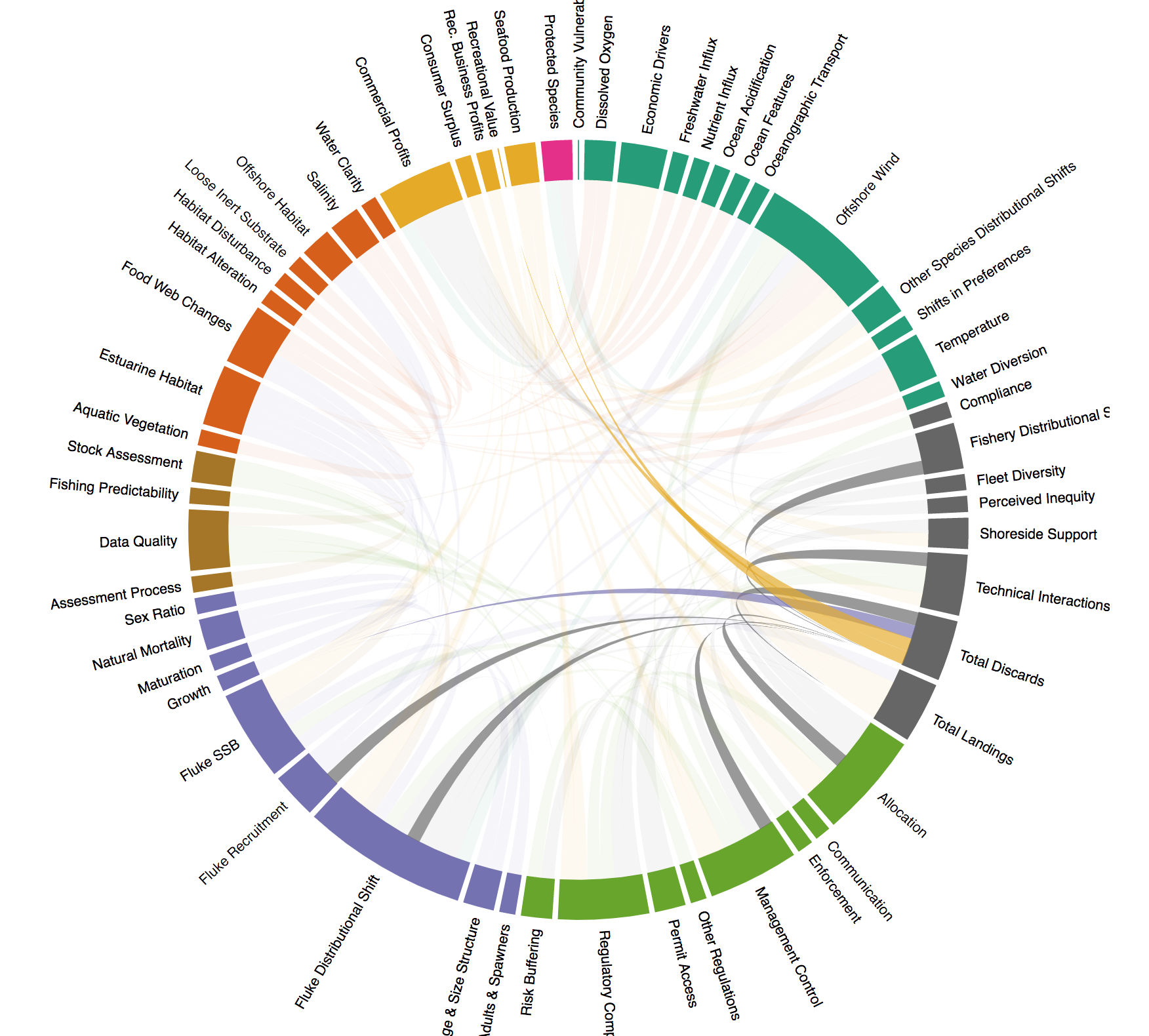  ] --- ## Mid-Atlantic EAFM next steps: management strategy evaluation .pull-left-40[ * Technical working group with similar approach and membership as used in conceptual model process + Diverse interdisciplinary and inter-agency membership – additional MSE expertise + Independent facilitator from outside the region * Introductory MSE workshop September 2020 + Joint federal and state management advisory panels + Stakeholdrs likely to participate in MSE process + Introduced MSE process, concepts, expectations + Simulated stakeholder workshop to understand participant role ] .pull-right-60[ 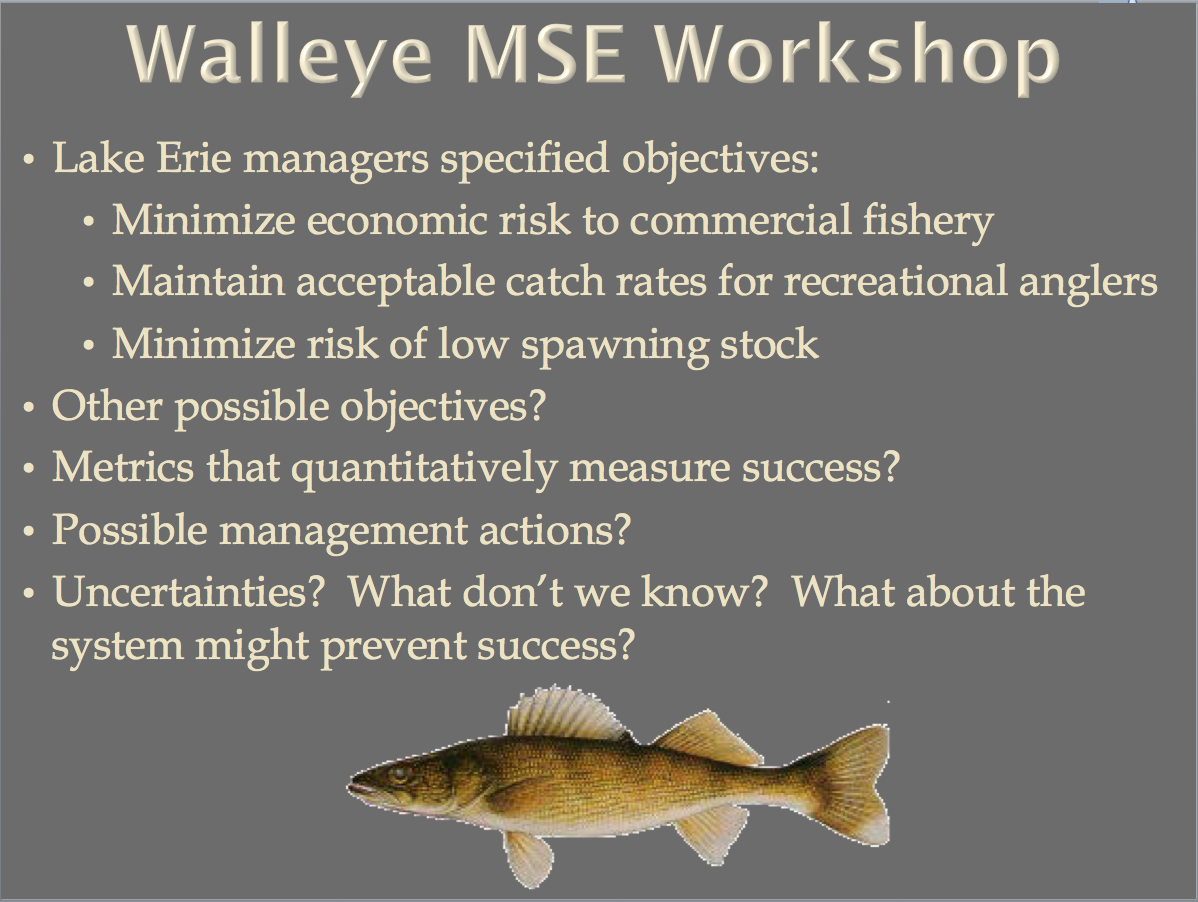 ] --- ## MSE approach and timeline .pull-left-40[ Anticipating 3 stakeholder workshops (next 12 – 15 months) * W1: Identify management objectives, performance metrics, and uncertainties * W2: Input on initial model development and results * W3: Review updated model and “final” results Iterative process with Committees/Council/Board ] .pull-right-60[ 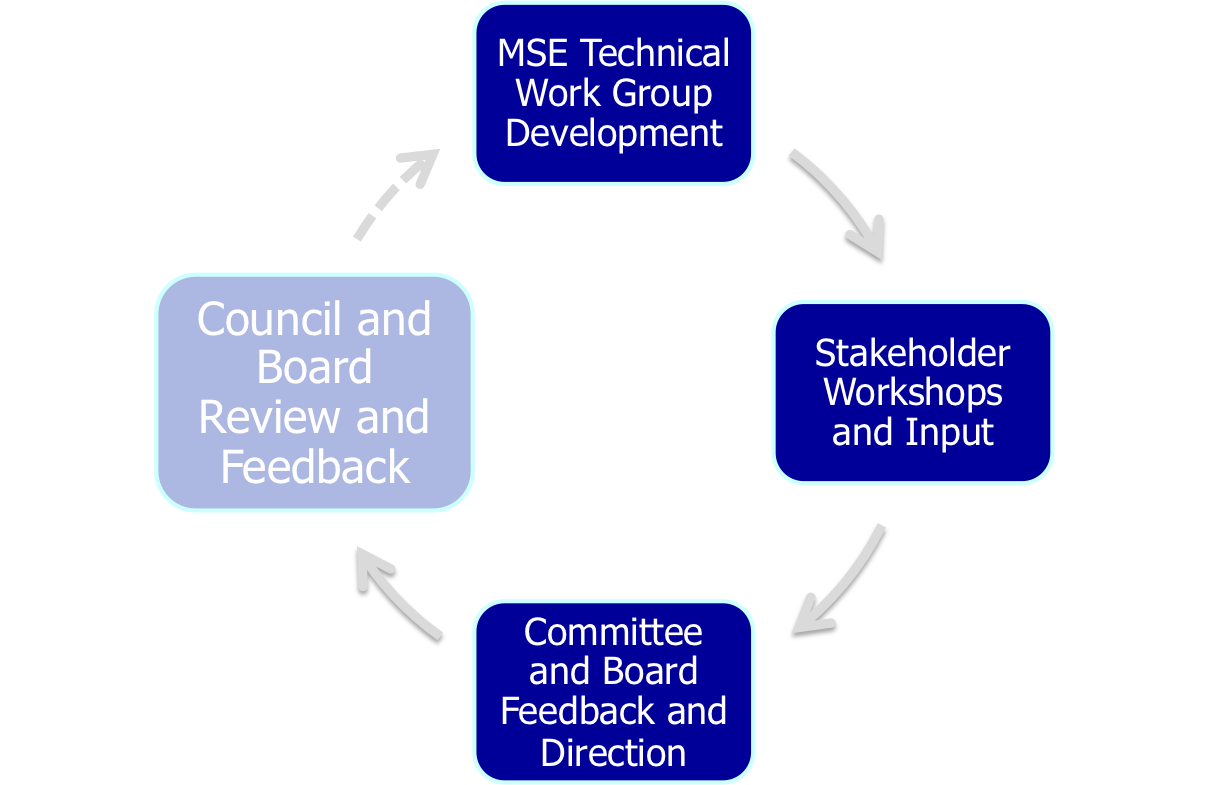 ] --- # Conclusions * The process takes time – need to recognize that early and be willing to invest the resources to see it through + Need the science to develop and support efforts + Need management (and stakeholders) to understand process and concepts and support process * Collaboration is key + Within the science community – diverse expertise is needed + Between science and management – understanding what information is needed and important to management, providing tools to management to understand ecosystem linkages and implications + Between science and stakeholders – need to build trust, open dialogue (everyone is heard), and sharing data and observations (on water and with information) + Between management and stakeholders – listening to/acting on stakeholder priorities and feedback, process not out to add more uncertainty but provide for more informed decisions * Timely and understandable scientific information + Developing a process to create science products at timescales necessary for management + Information needs to be relevant and clearly presented + Flexibility to use different/alternative data sources when specific data in not available (proxies) --- ## References .contrib[ <a name=bib-bastille_improving_2020></a>[Bastille, K. et al.](#cite-bastille_improving_2020) (2020). "Improving the IEA Approach Using Principles of Open Data Science". In: _Coastal Management_ 0.0. Publisher: Taylor & Francis \_ eprint: https://doi.org/10.1080/08920753.2021.1846155, pp. 1-18. ISSN: 0892-0753. DOI: [10.1080/08920753.2021.1846155](https://doi.org/10.1080%2F08920753.2021.1846155). URL: [https://doi.org/10.1080/08920753.2021.1846155](https://doi.org/10.1080/08920753.2021.1846155) (visited on Dec. 09, 2020). <a name=bib-depiper_operationalizing_2017></a>[DePiper, G. S. et al.](#cite-depiper_operationalizing_2017) (2017). "Operationalizing integrated ecosystem assessments within a multidisciplinary team: lessons learned from a worked example". En. In: _ICES Journal of Marine Science_ 74.8, pp. 2076-2086. ISSN: 1054-3139. DOI: [10.1093/icesjms/fsx038](https://doi.org/10.1093%2Ficesjms%2Ffsx038). URL: [https://academic.oup.com/icesjms/article/74/8/2076/3094701](https://academic.oup.com/icesjms/article/74/8/2076/3094701) (visited on Mar. 09, 2018). <a name=bib-gaichas_implementing_2018></a>[Gaichas, S. K. et al.](#cite-gaichas_implementing_2018) (2018). "Implementing Ecosystem Approaches to Fishery Management: Risk Assessment in the US Mid-Atlantic". In: _Frontiers in Marine Science_ 5. ISSN: 2296-7745. DOI: [10.3389/fmars.2018.00442](https://doi.org/10.3389%2Ffmars.2018.00442). URL: [https://www.frontiersin.org/articles/10.3389/fmars.2018.00442/abstract](https://www.frontiersin.org/articles/10.3389/fmars.2018.00442/abstract) (visited on Nov. 20, 2018). <a name=bib-gaichas_framework_2016></a>[Gaichas, S. K. et al.](#cite-gaichas_framework_2016) (2016). "A Framework for Incorporating Species, Fleet, Habitat, and Climate Interactions into Fishery Management". In: _Frontiers in Marine Science_ 3. ISSN: 2296-7745. DOI: [10.3389/fmars.2016.00105](https://doi.org/10.3389%2Ffmars.2016.00105). URL: [https://www.frontiersin.org/articles/10.3389/fmars.2016.00105/full](https://www.frontiersin.org/articles/10.3389/fmars.2016.00105/full) (visited on Apr. 29, 2020). <a name=bib-muffley_there_2020></a>[Muffley, B. et al.](#cite-muffley_there_2020) (2020). "There Is no I in EAFM Adapting Integrated Ecosystem Assessment for Mid-Atlantic Fisheries Management". In: _Coastal Management_ 0.0. Publisher: Taylor & Francis \_ eprint: https://doi.org/10.1080/08920753.2021.1846156, pp. 1-17. ISSN: 0892-0753. DOI: [10.1080/08920753.2021.1846156](https://doi.org/10.1080%2F08920753.2021.1846156). URL: [https://doi.org/10.1080/08920753.2021.1846156](https://doi.org/10.1080/08920753.2021.1846156) (visited on Dec. 09, 2020). DePiper, G., Gaichas, S., Muffley, B., Ardini, G., Brust, J., Coakley, J., Dancy, K., Elliott, G.W., Leaning, D.C., Lipton, D., McNamee, J., Palmer, D., Perretti, C., Rootes-Murdy, K., Wilberg, M. In review at ICES Journal of Marine Science. Learning by doing: Collaborative conceptual modeling as a path forward in Ecosystem-based Management. ] --- ## Additional resources .pull-left[ * [2020 State of the Ecosystem Reports](https://www.fisheries.noaa.gov/new-england-mid-atlantic/ecosystems/state-ecosystem-reports-northeast-us-shelf) * [ecodata R package](https://github.com/noaa-edab/ecodata) * Visualizations: * [Mid-Atlantic Human Dimensions indicators](http://noaa-edab.github.io/ecodata/human_dimensions_MAB) * [Mid-Atlantic Macrofauna indicators](http://noaa-edab.github.io/ecodata/macrofauna_MAB) * [Mid-Atlantic Lower trophic level indicators](https://noaa-edab.github.io/ecodata/LTL_MAB) * [New England Human Dimensions indicators](http://noaa-edab.github.io/ecodata/human_dimensions_NE) * [New England Macrofauna indicators](http://noaa-edab.github.io/ecodata/macrofauna_NE) * [New England Lower trophic level indicators](https://noaa-edab.github.io/ecodata/LTL_NE) * [SOE Technical Documentation](https://noaa-edab.github.io/tech-doc) * [Draft indicator catalogue](https://noaa-edab.github.io/catalog/) ] .pull-right[ * [Mid-Atlantic ecosystem approach](https://www.mafmc.org/eafm) * [Mid-Atlantic Council Summer Flounder conceptual model, support tables](https://gdepiper.github.io/Summer_Flounder_Conceptual_Models/sfconsmod_riskfactors_subplots.html) * [Management questions and conceptual model](https://gdepiper.github.io/Summer_Flounder_Conceptual_Models/sfconsmod_final_2col.html) * [Mid-Atantic April 2020 EAFM updates, including SOE](https://www.mafmc.org/s/Tab01_2020-SOE-Report_2020-04.pdf) .contrib[ * Slides available at https://noaa-edab.github.io/presentations * Contact: <Sarah.Gaichas@noaa.gov> ] ]